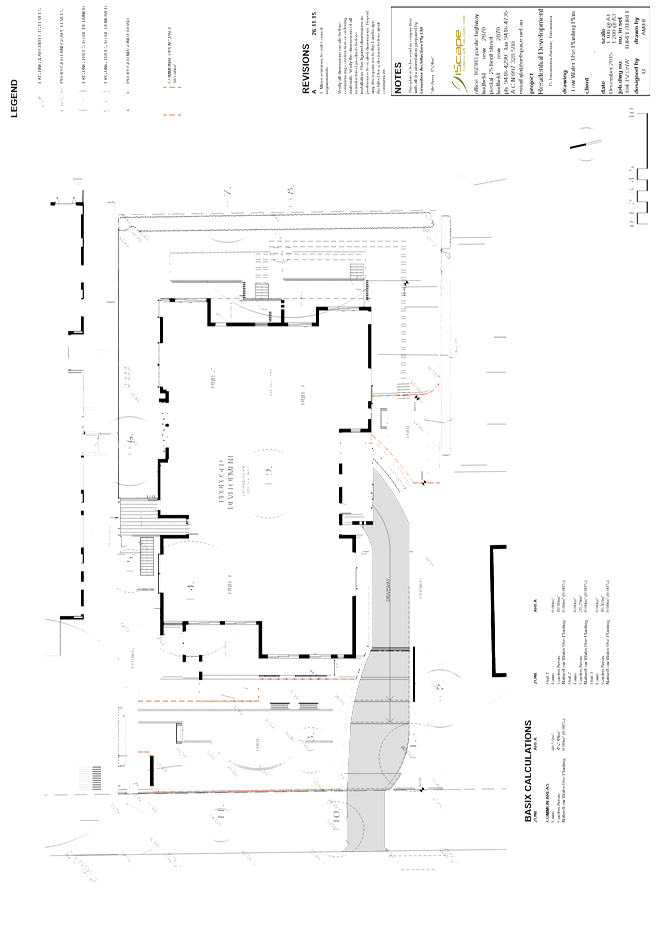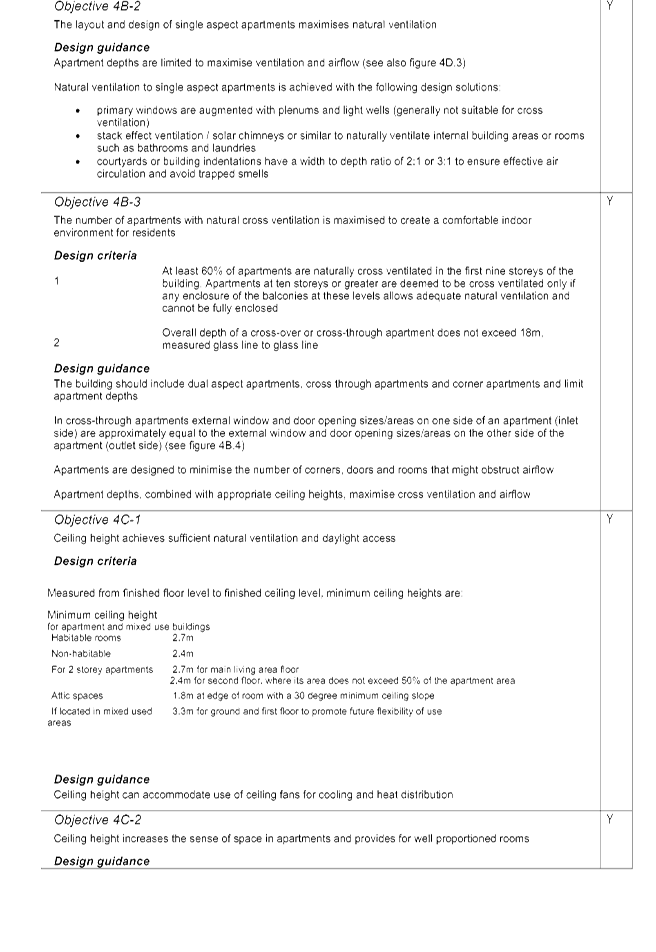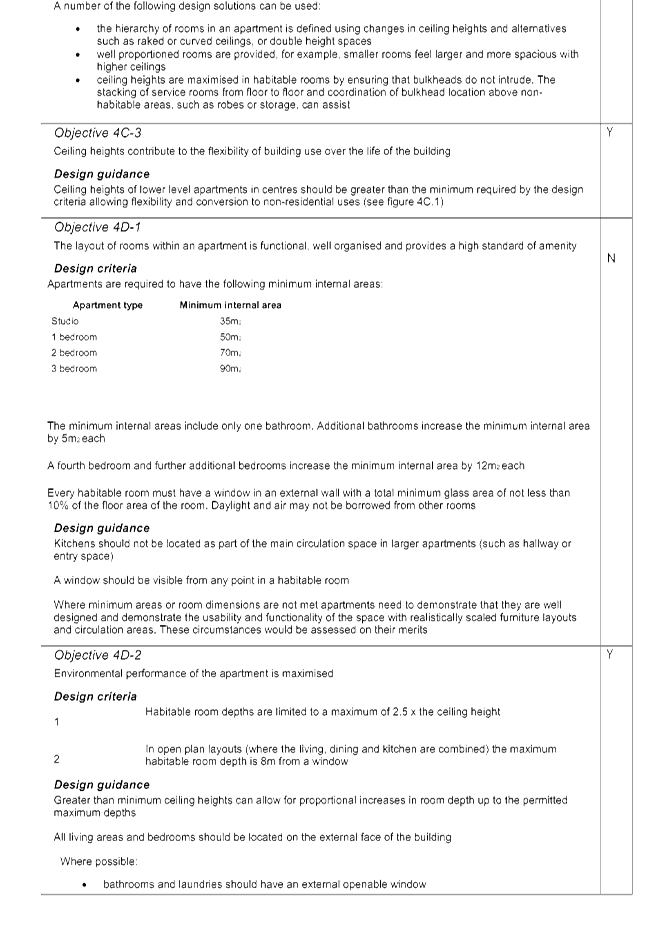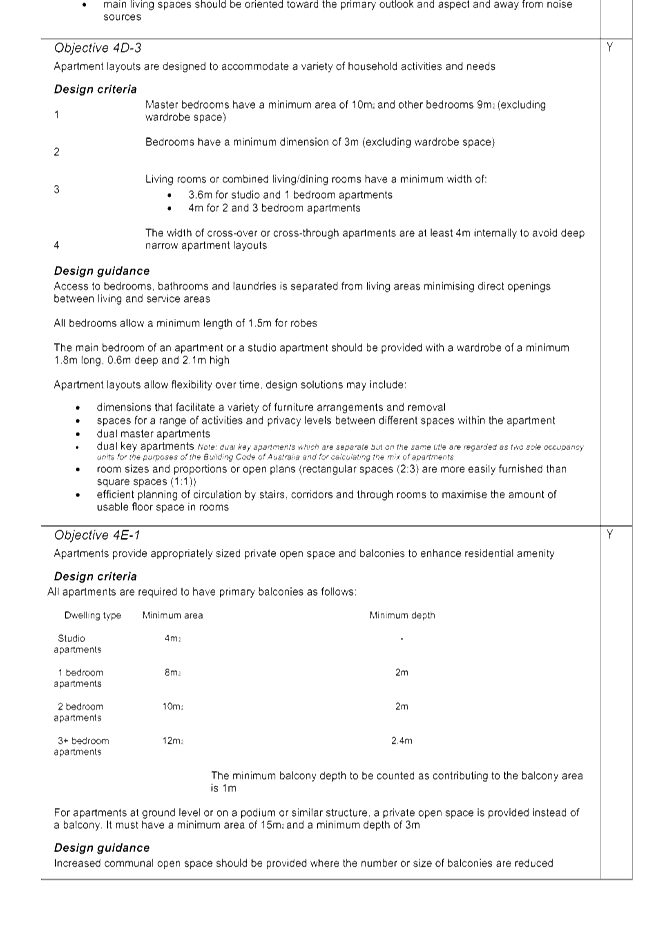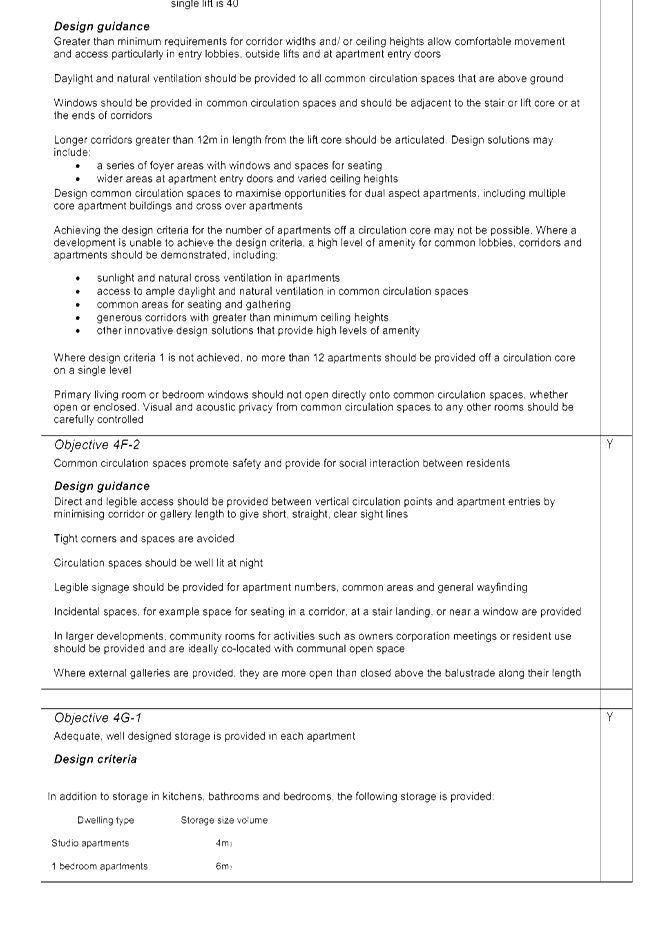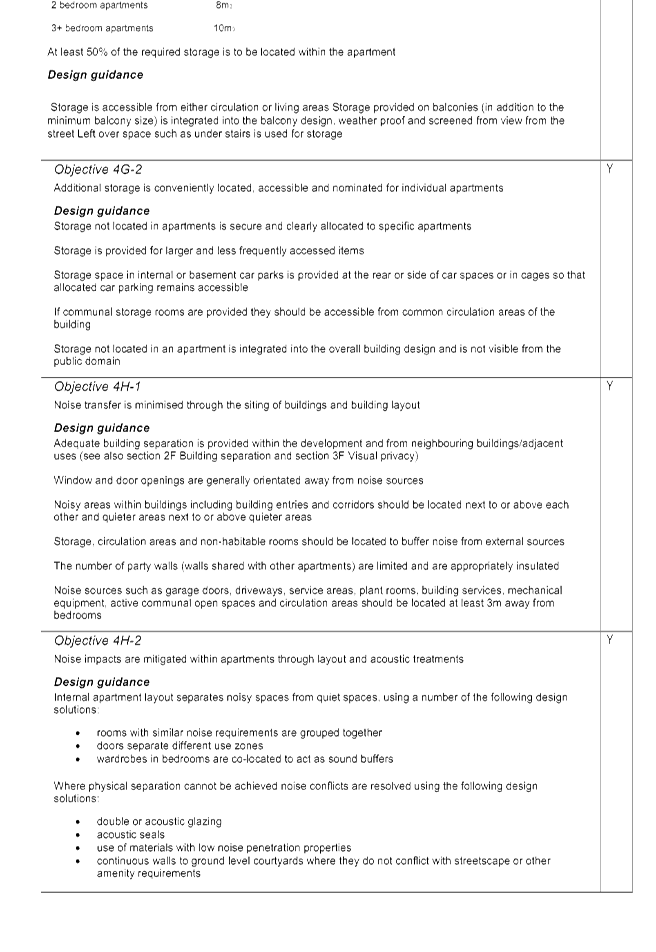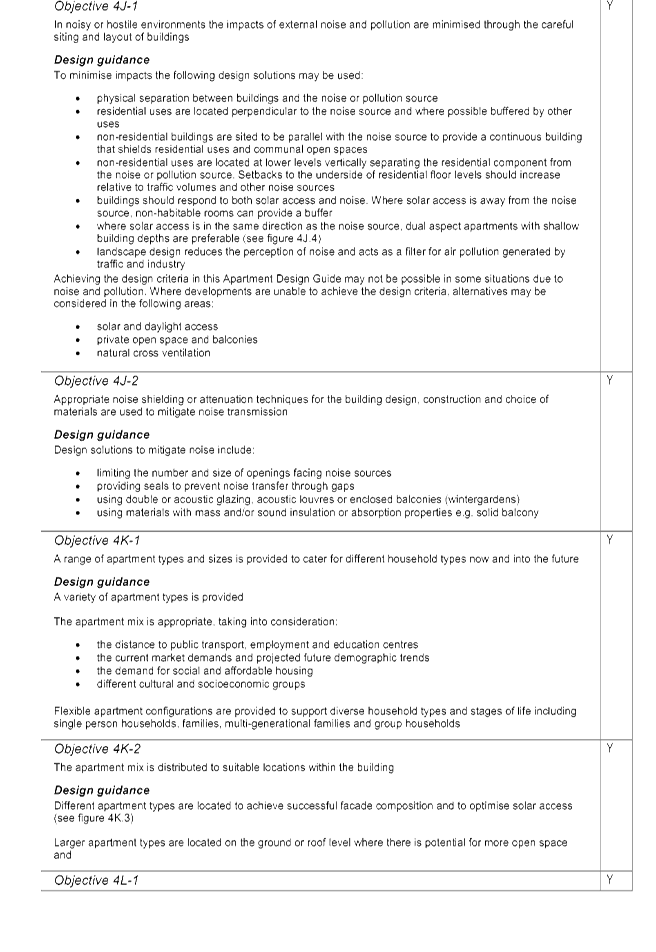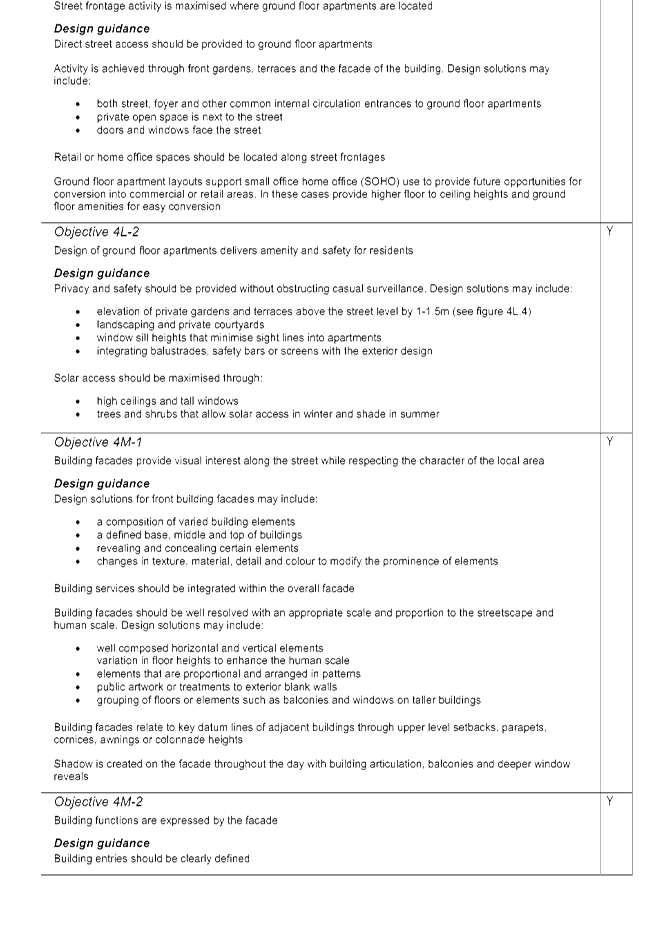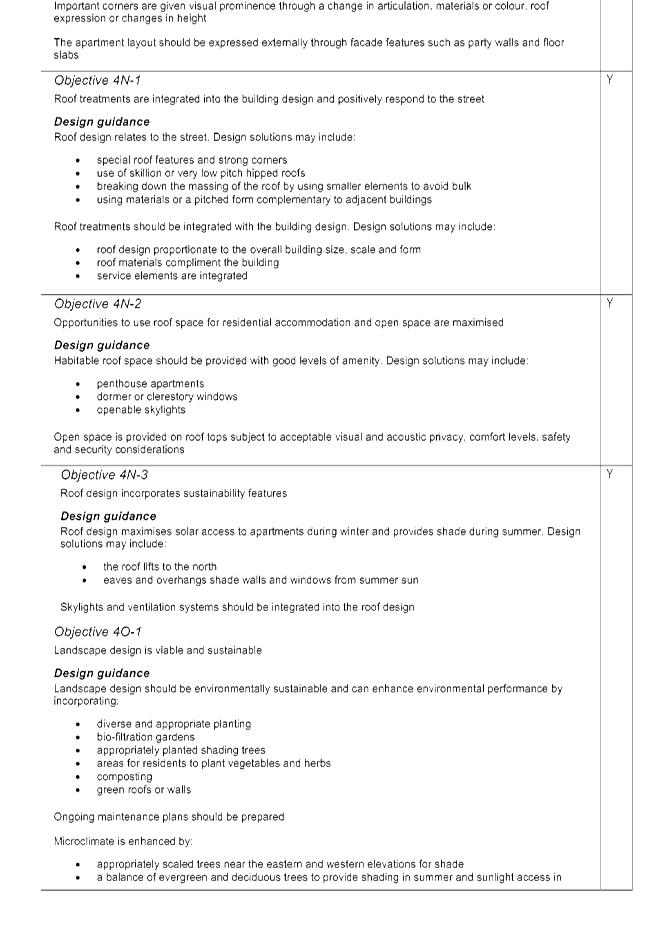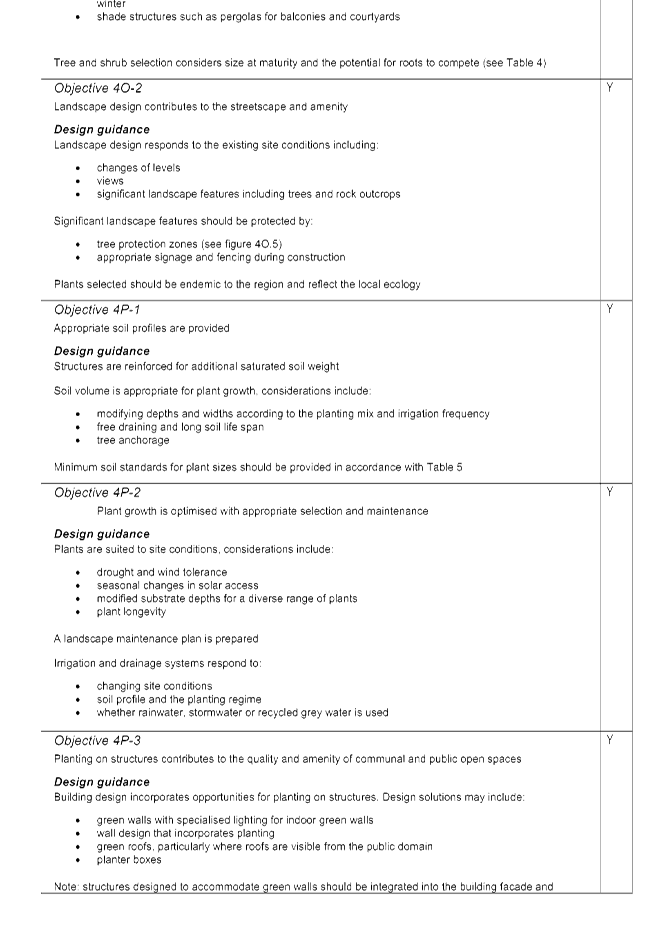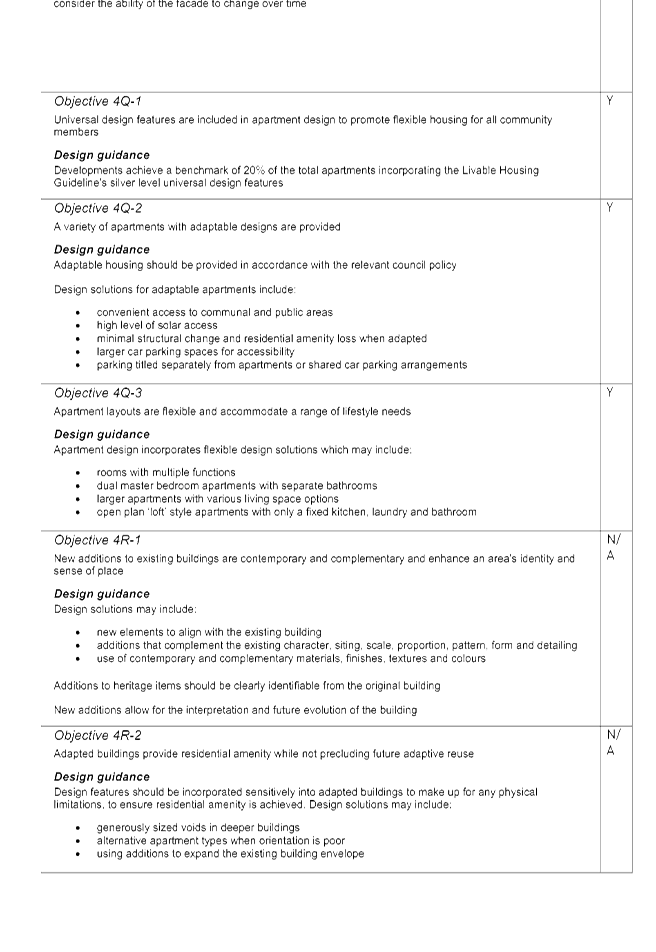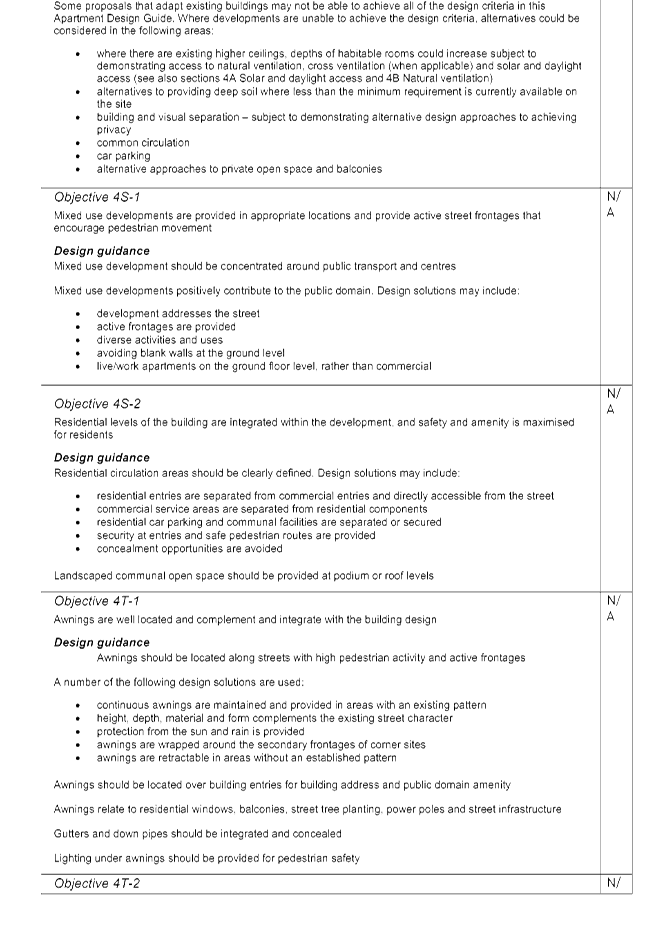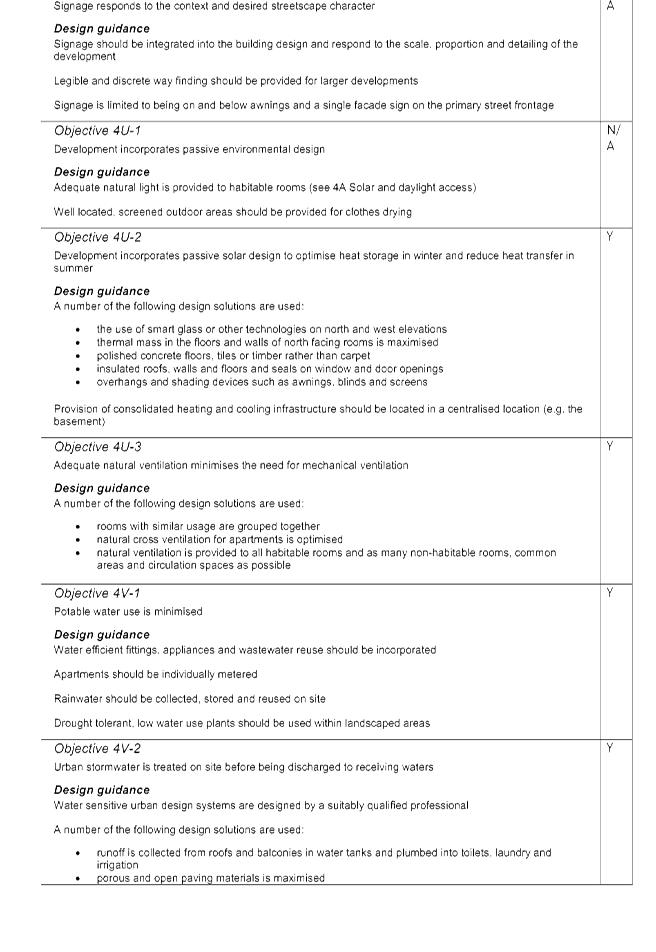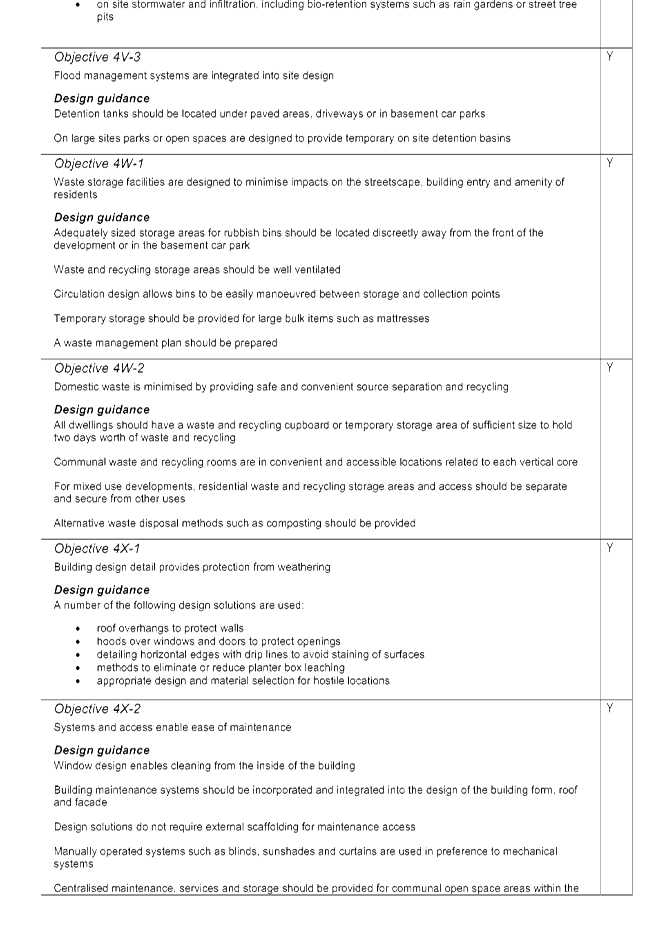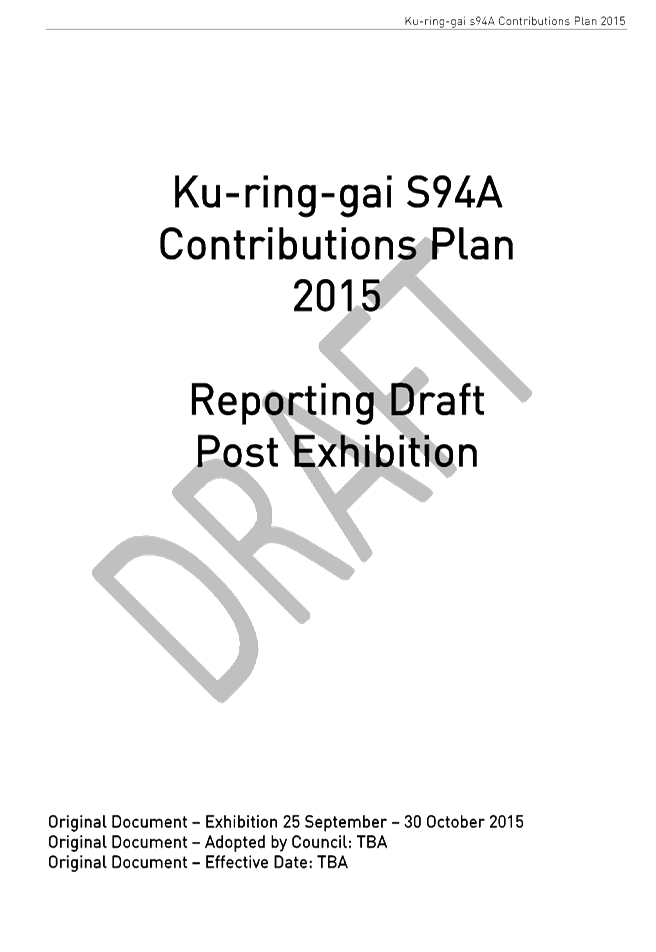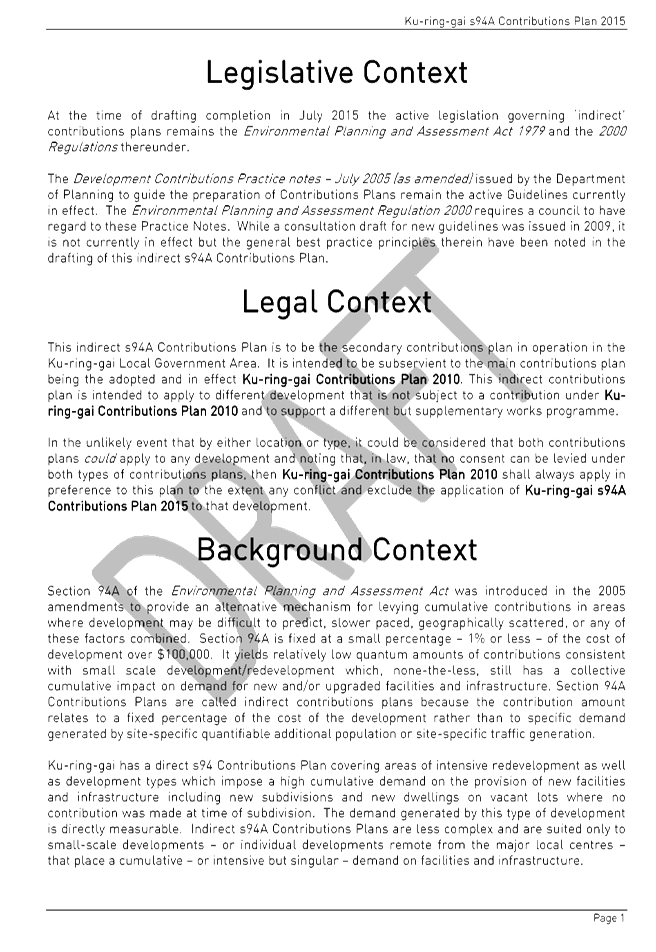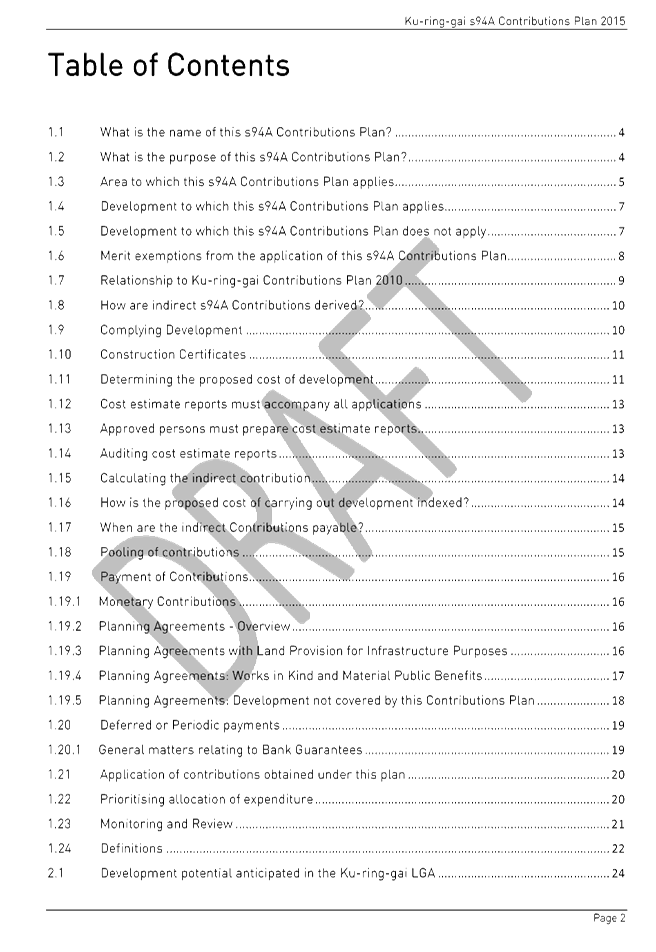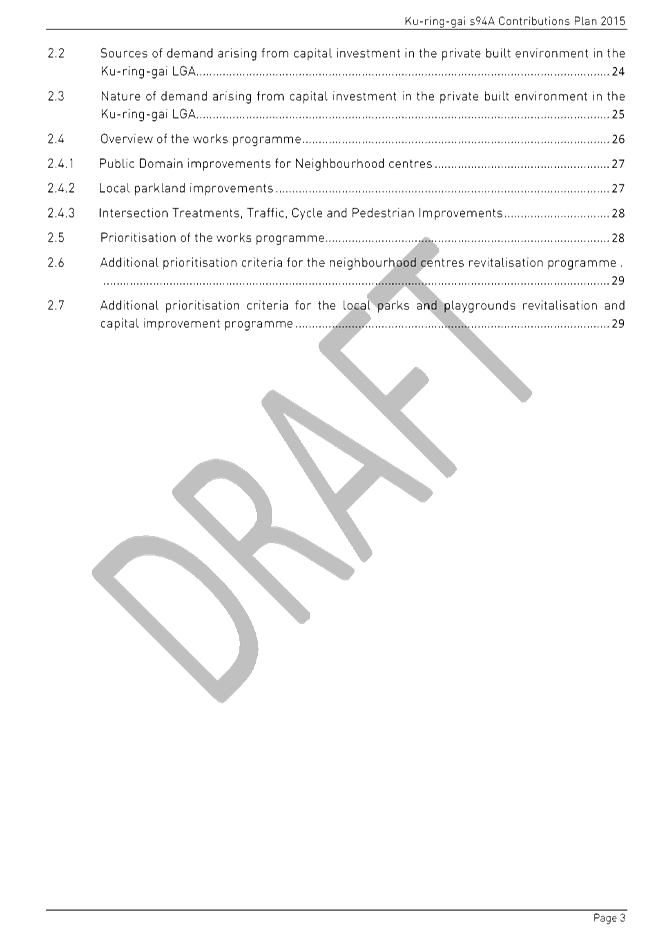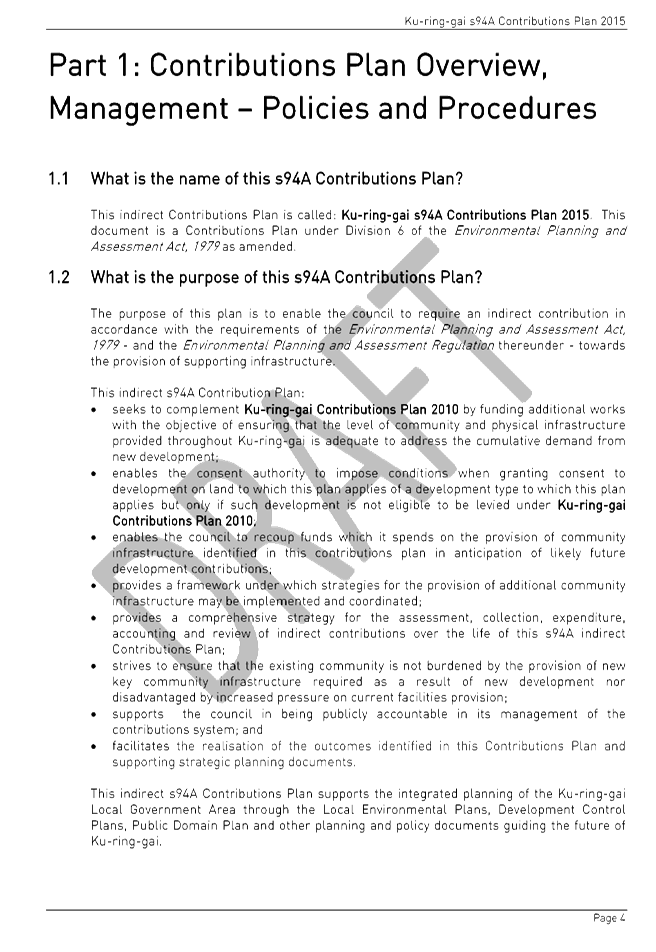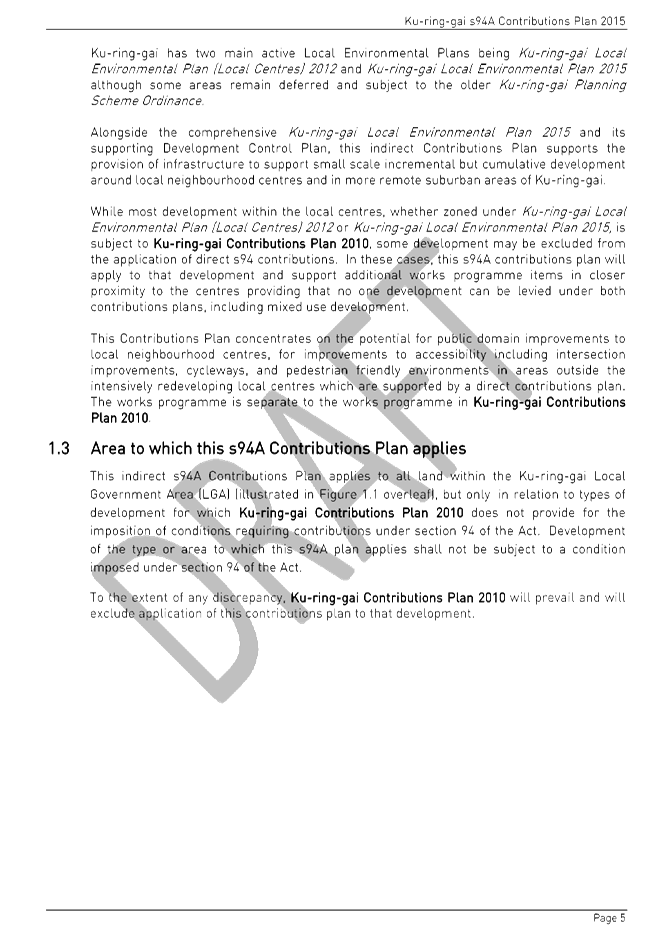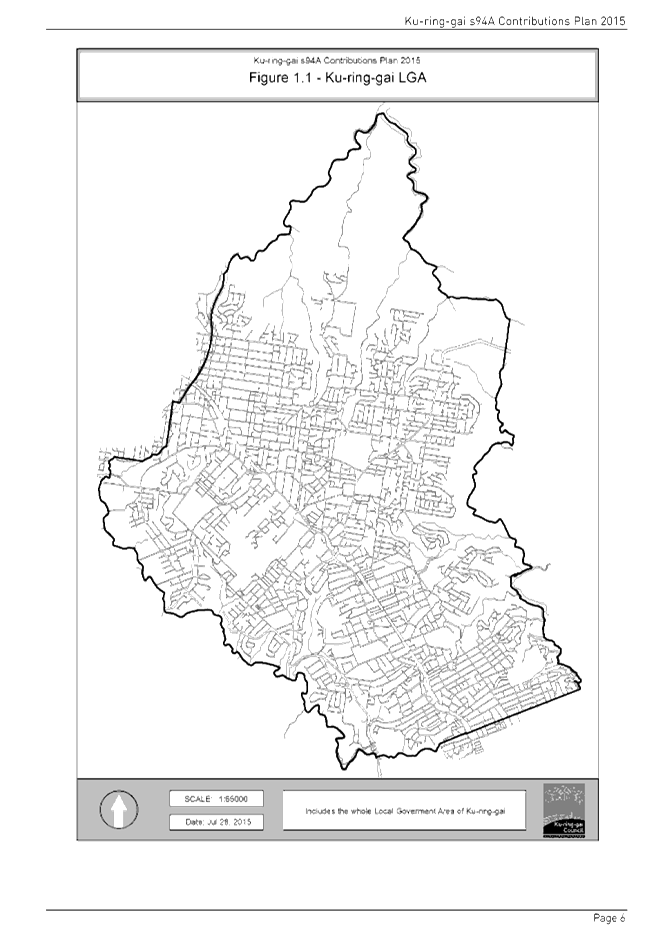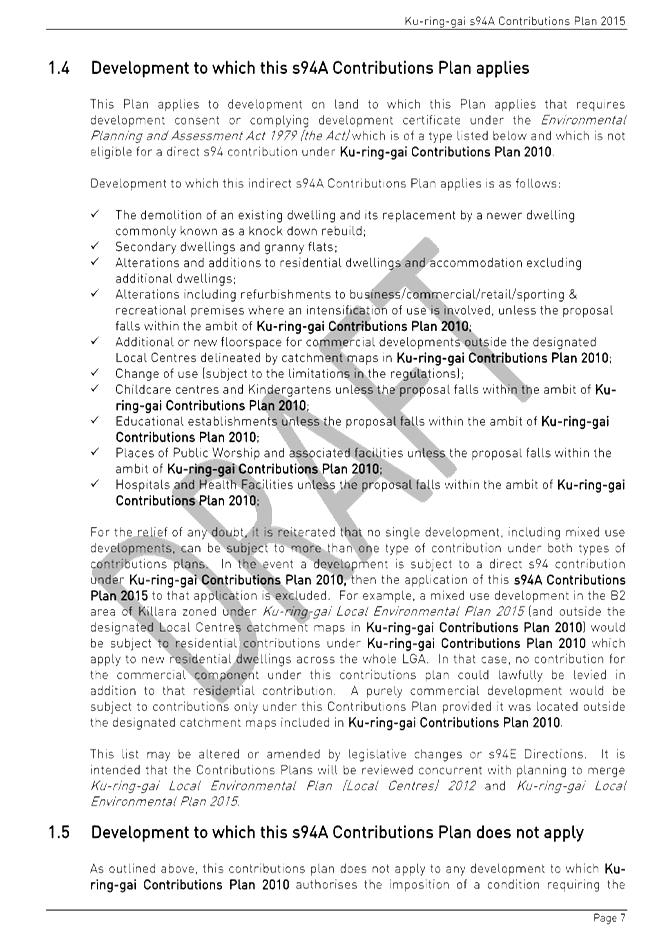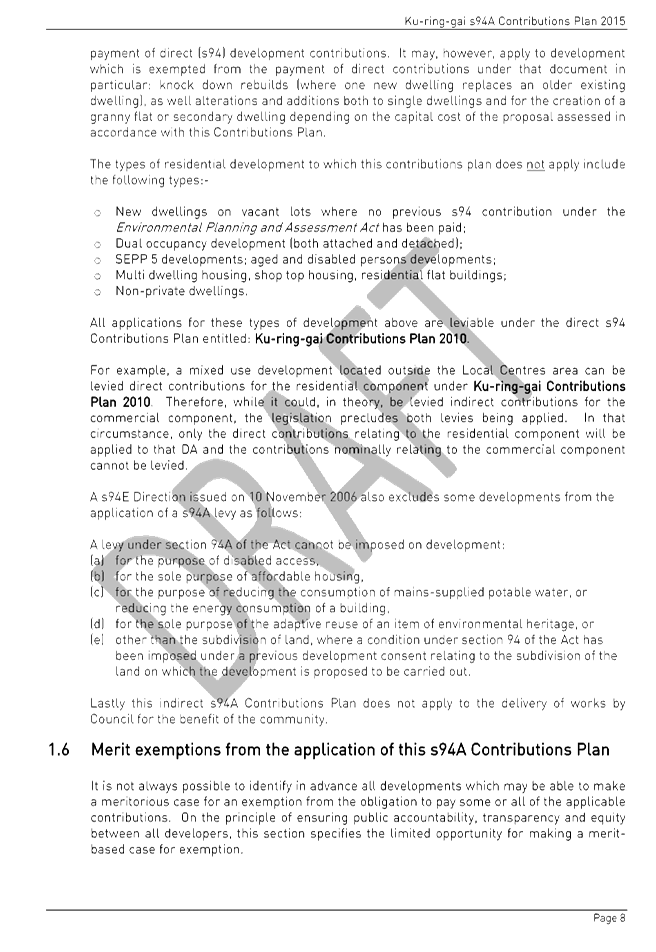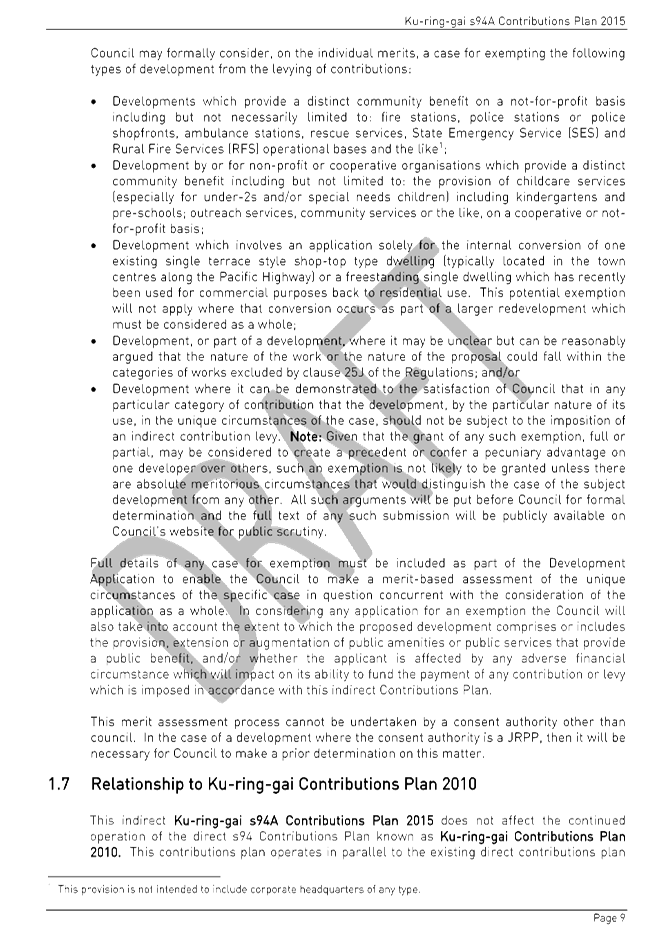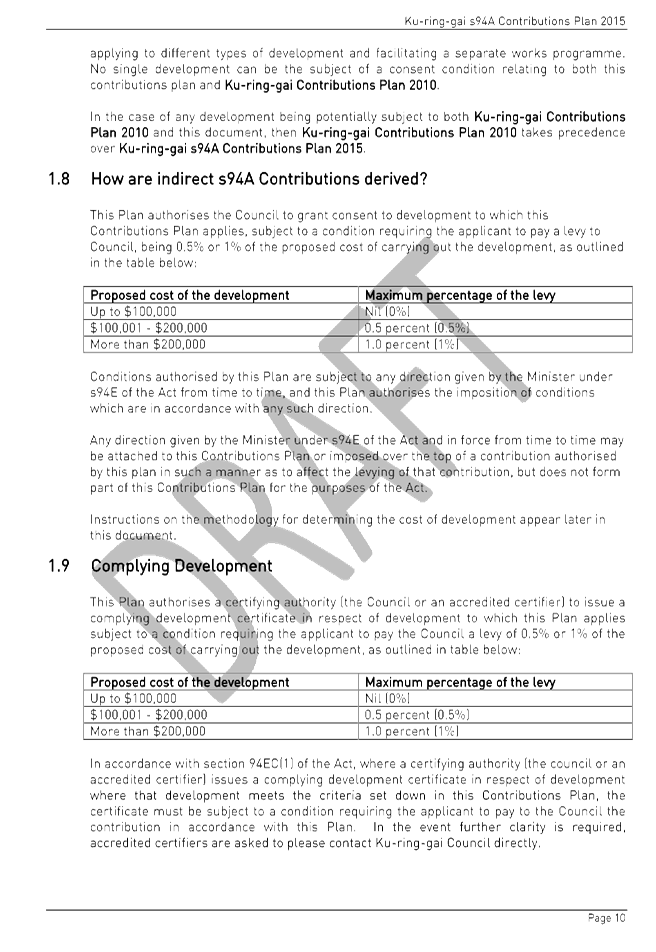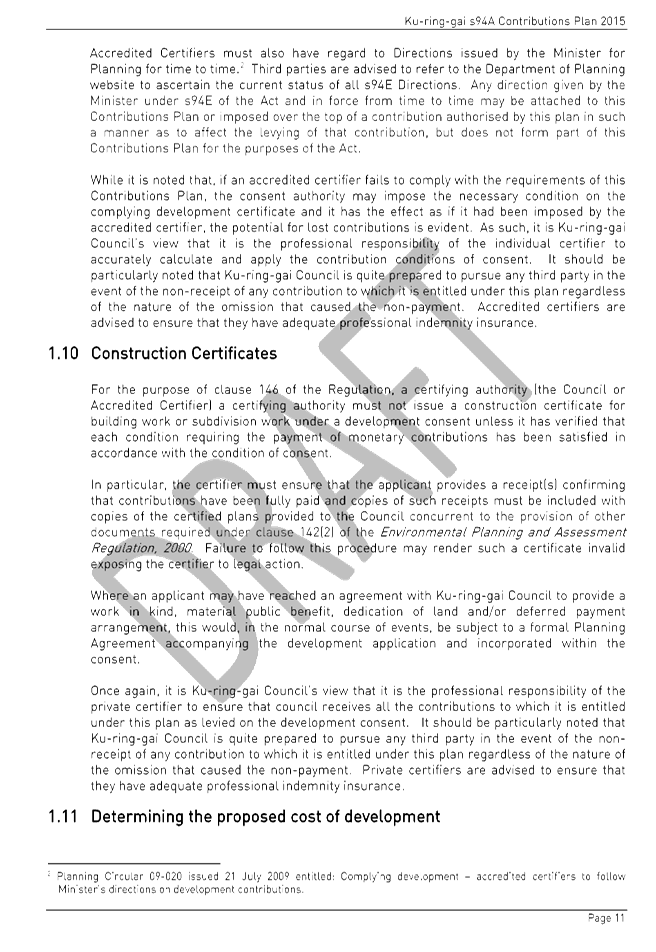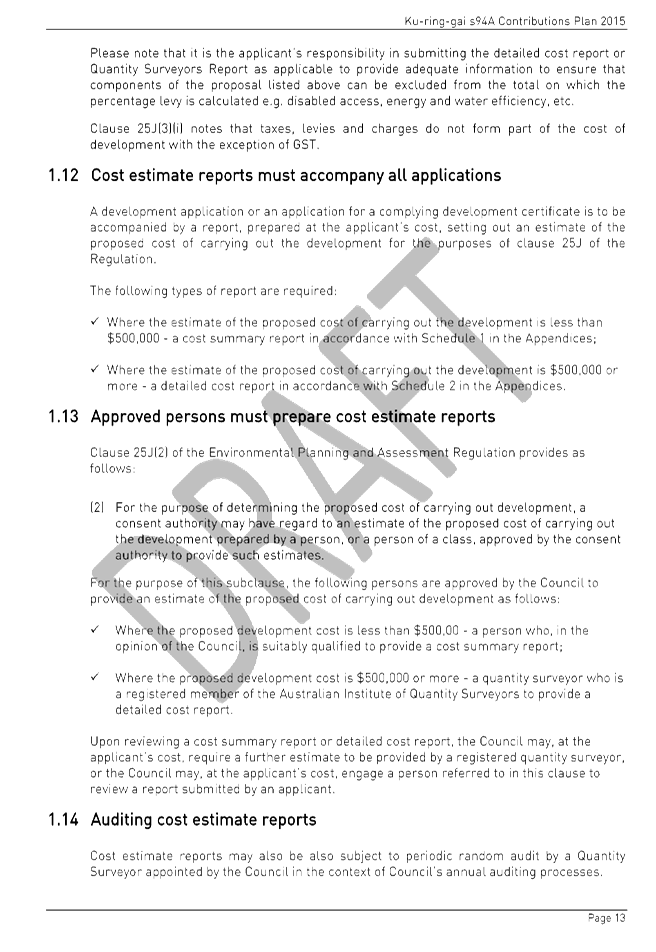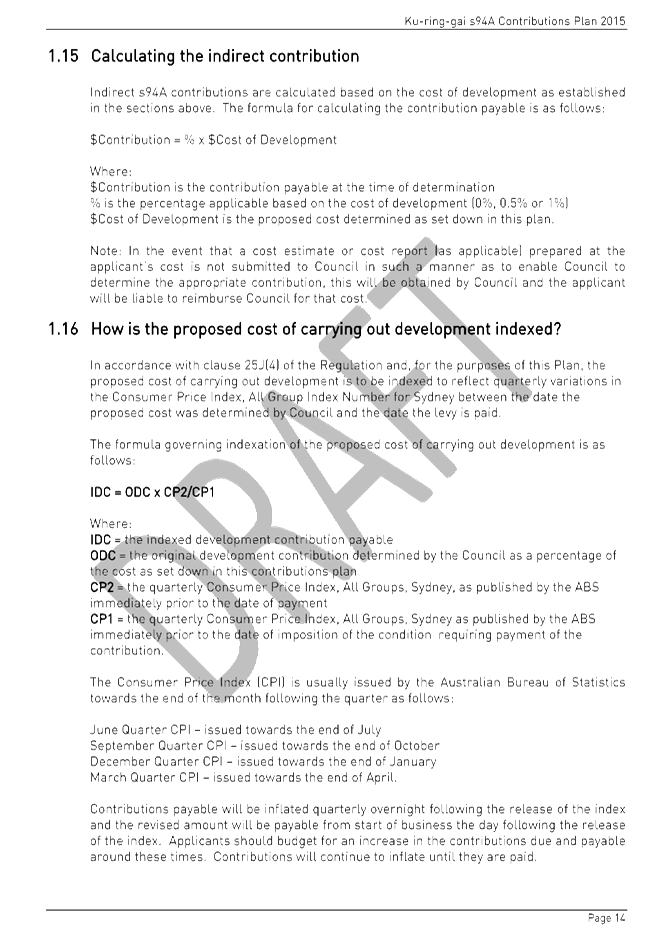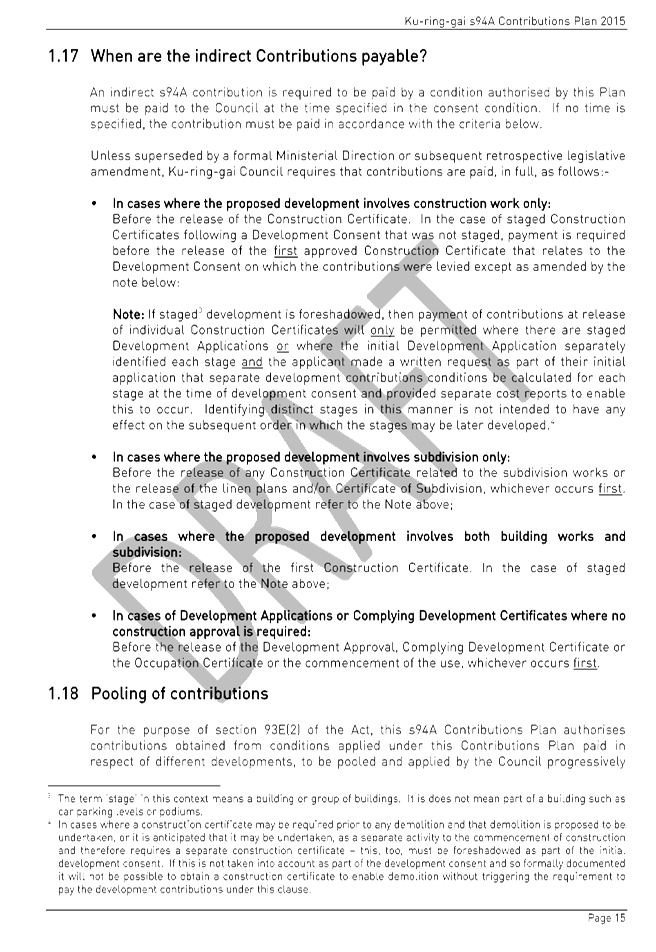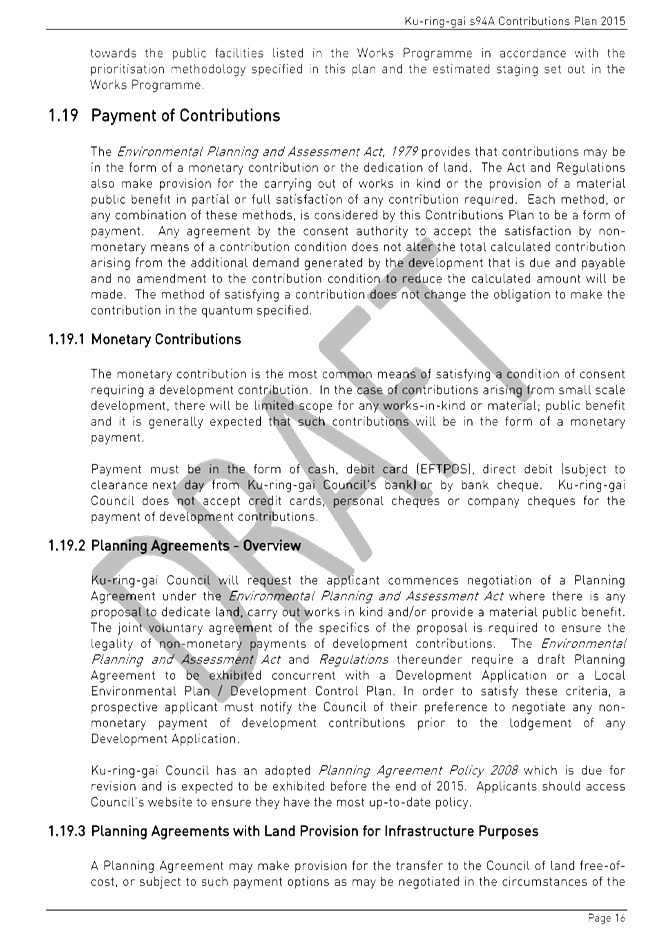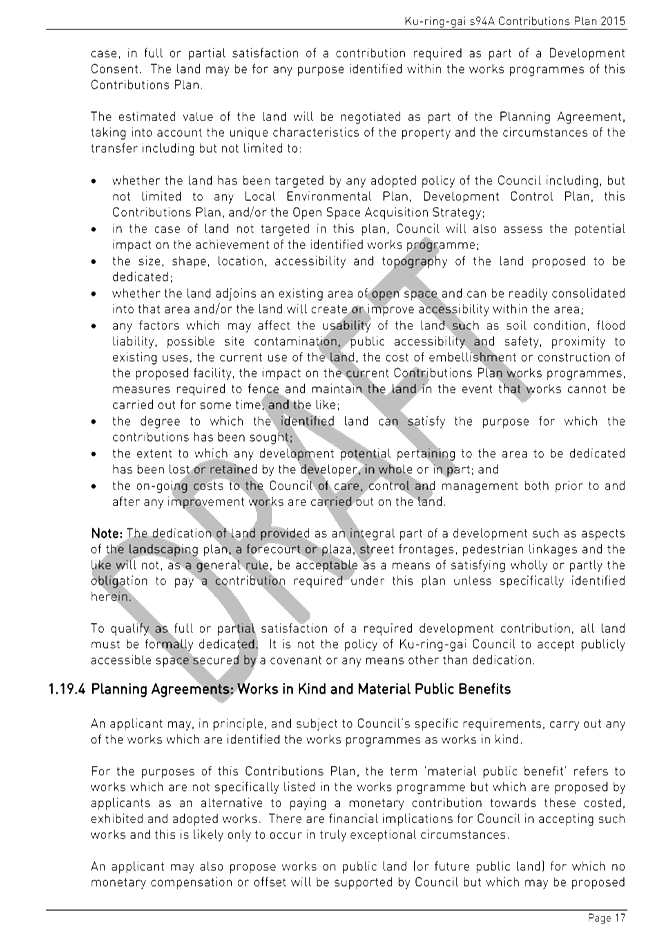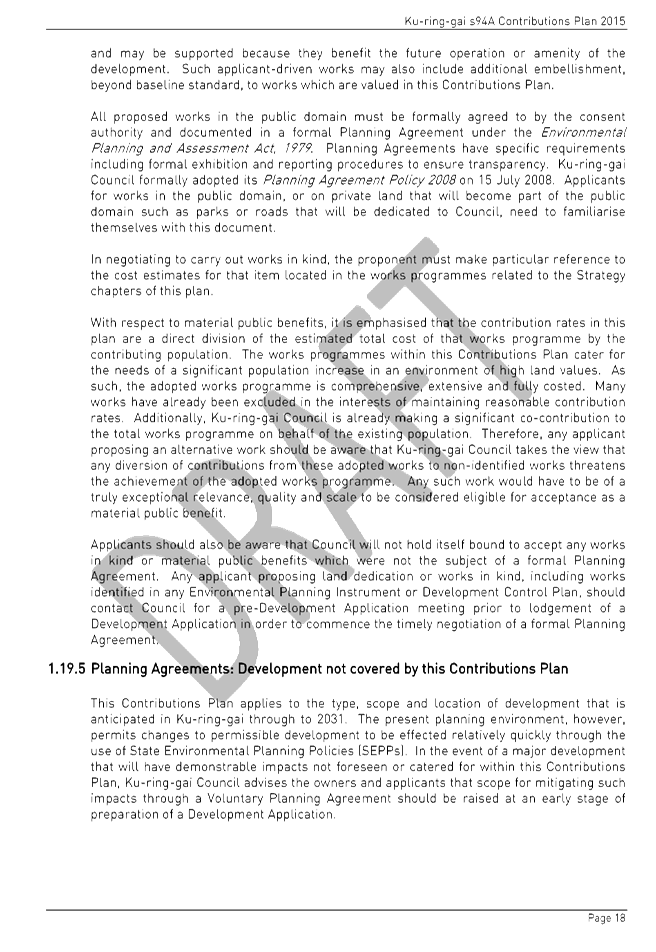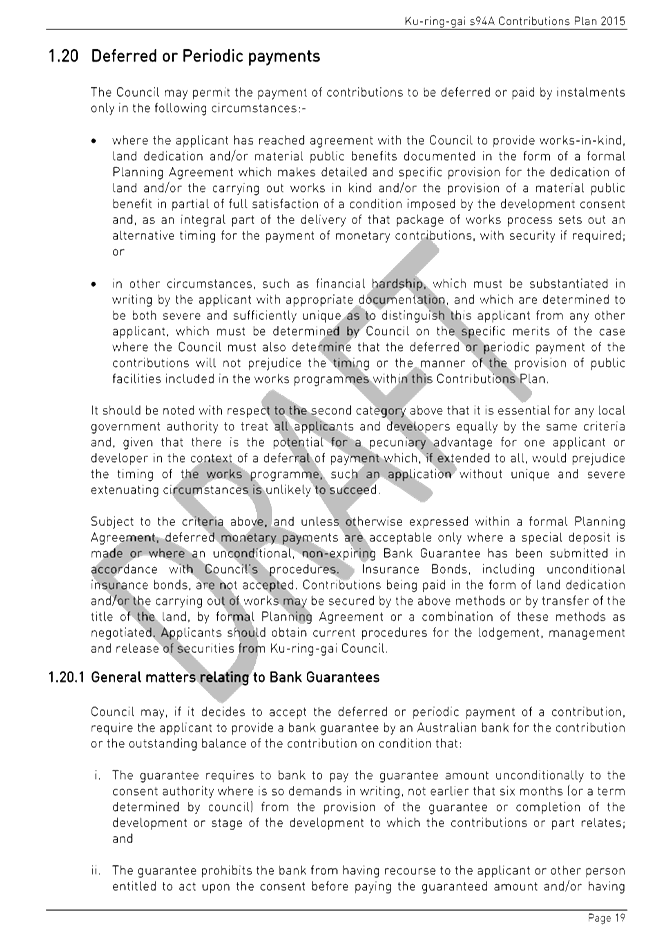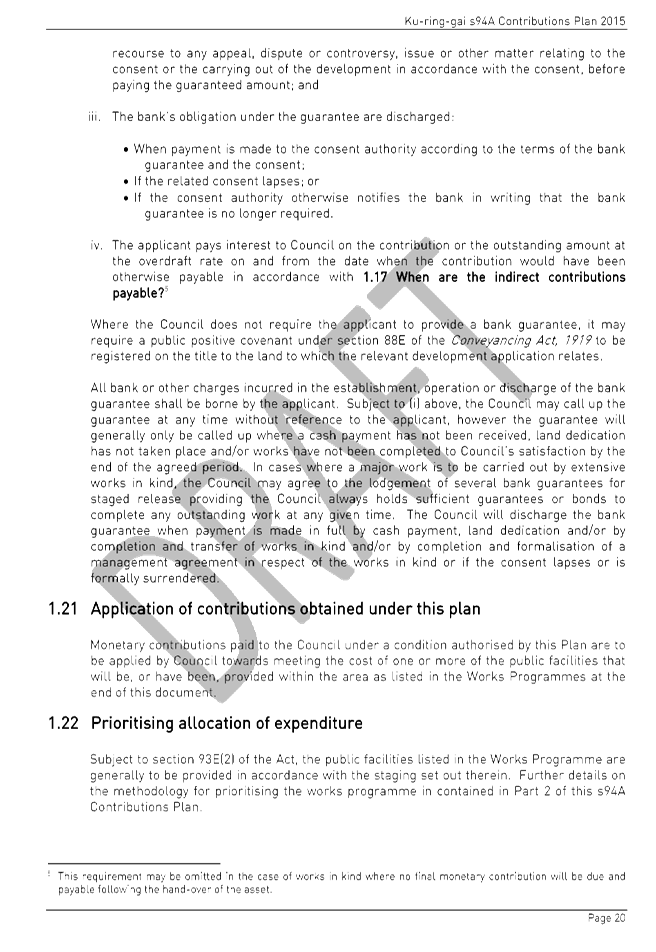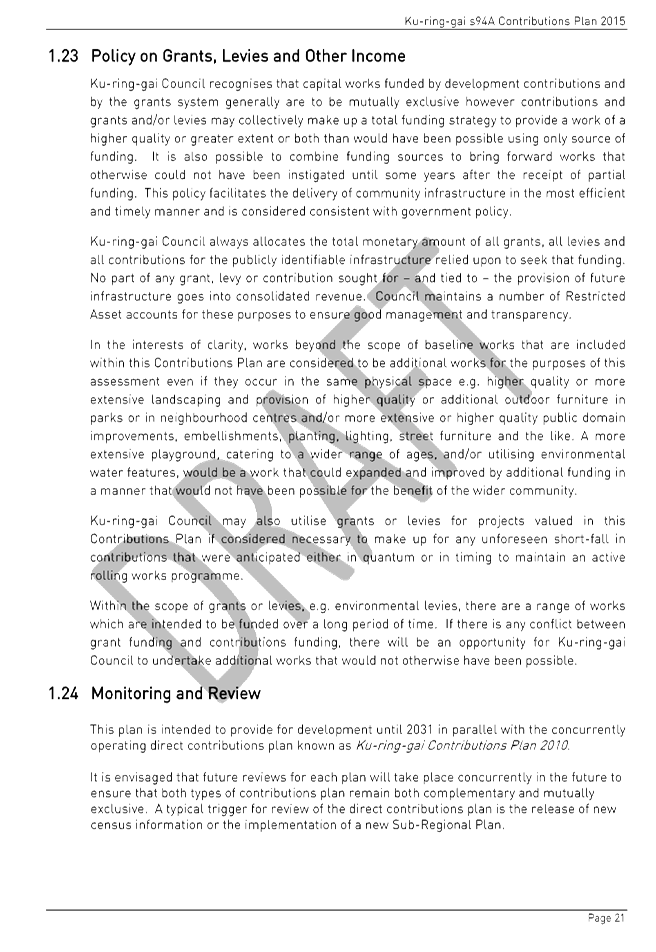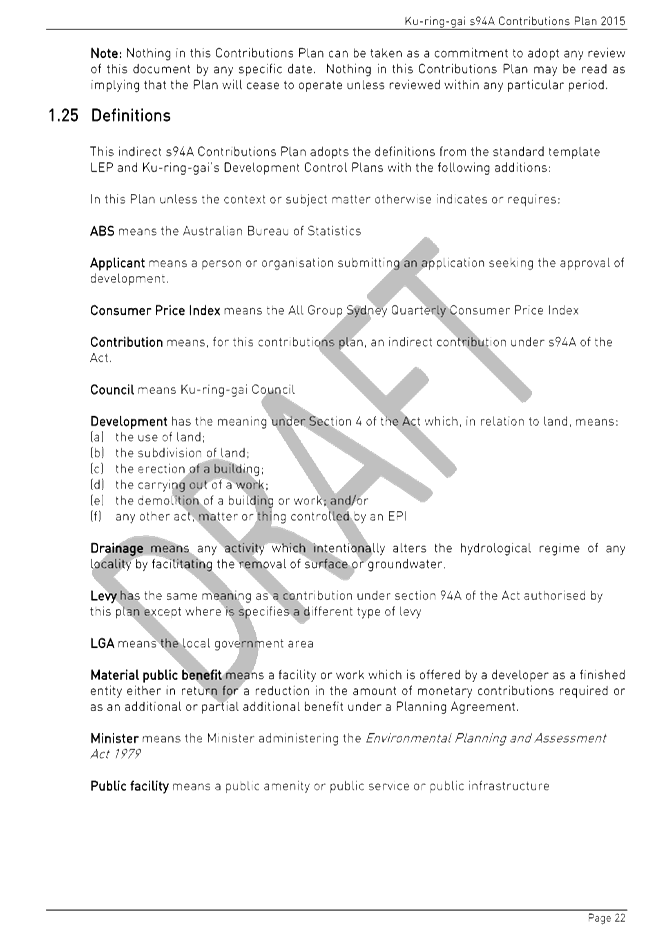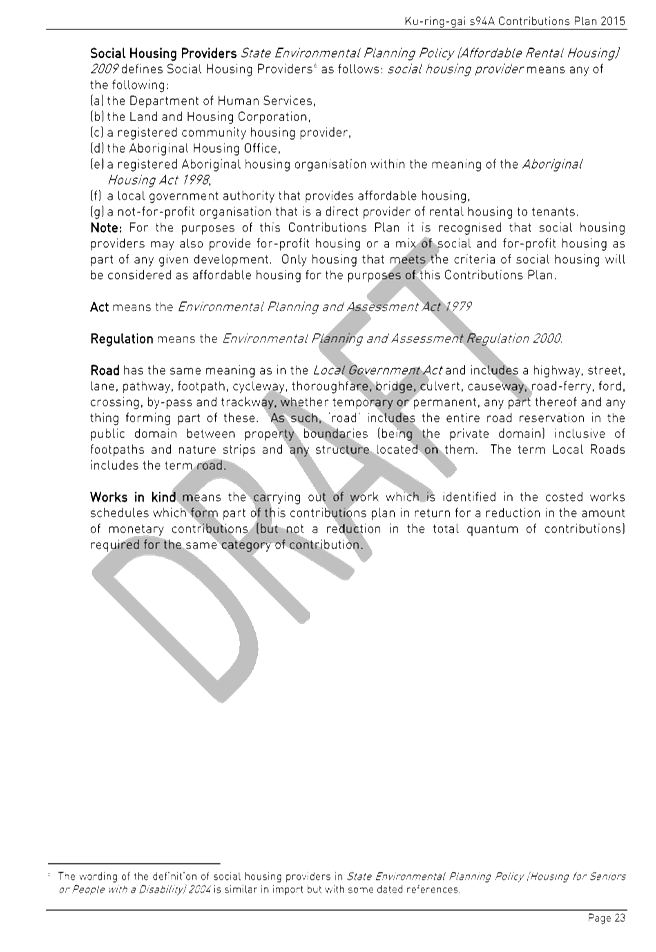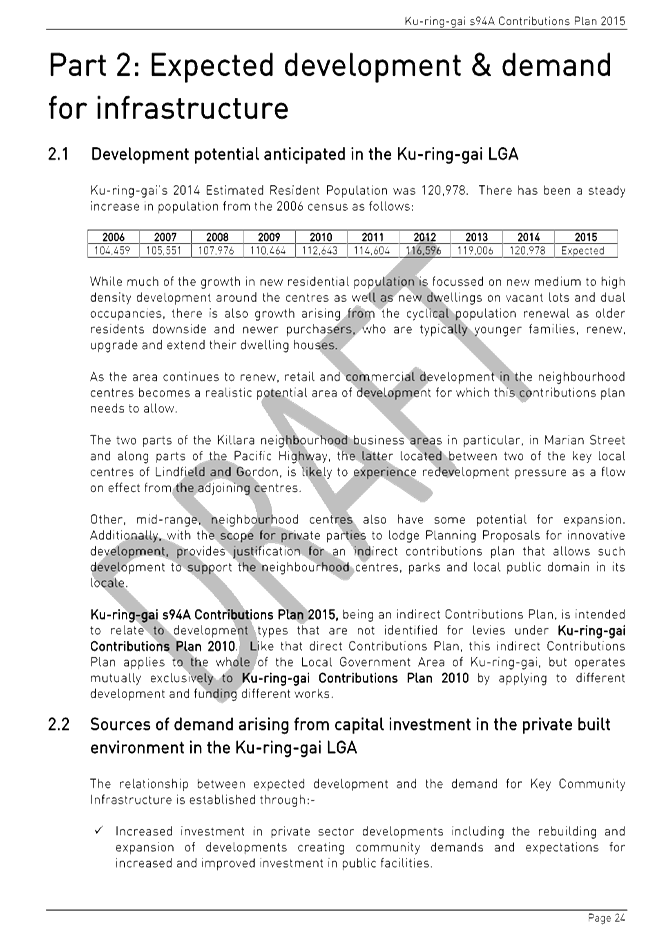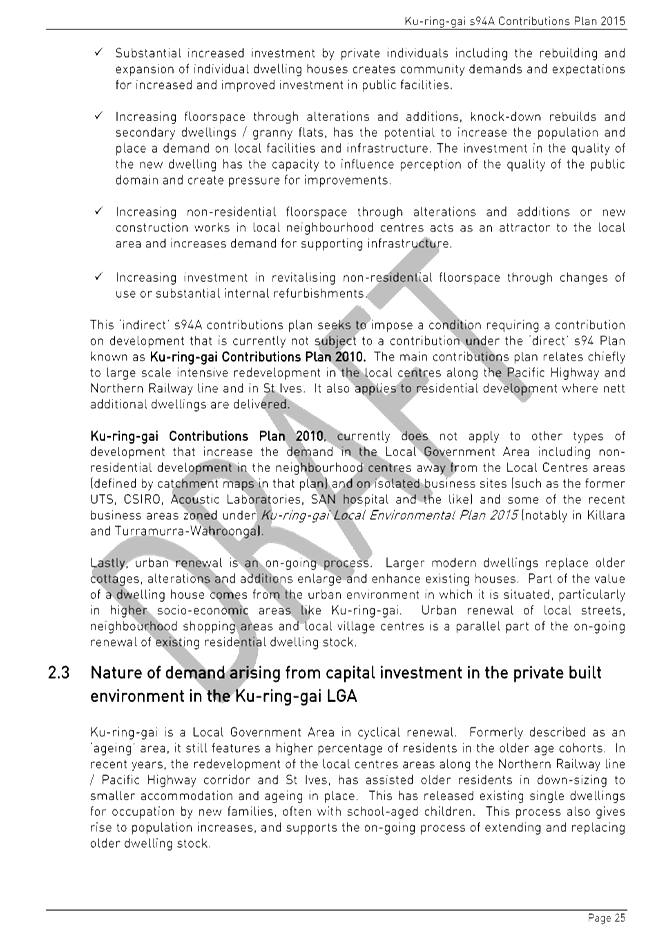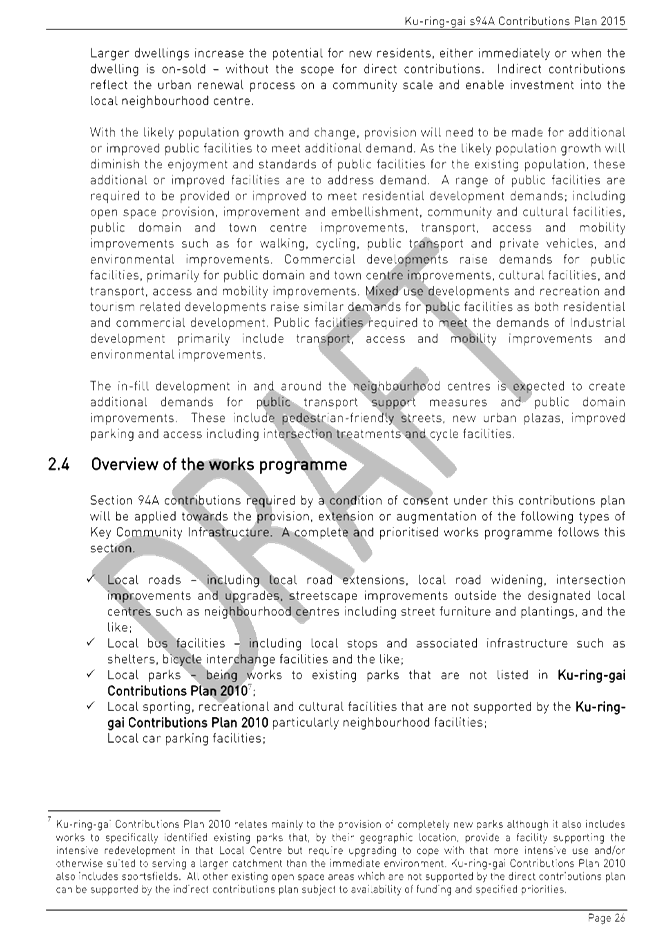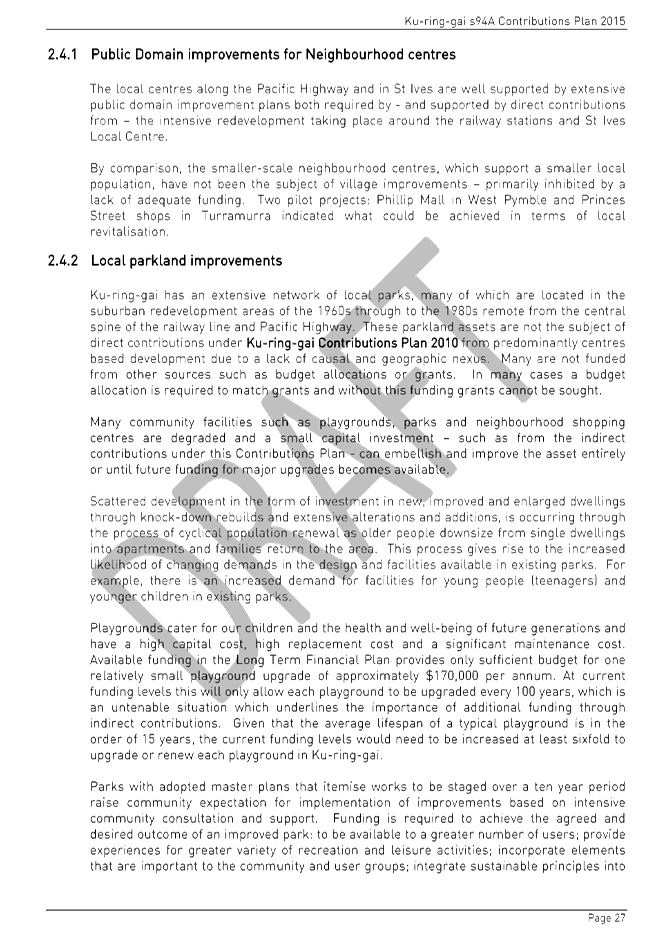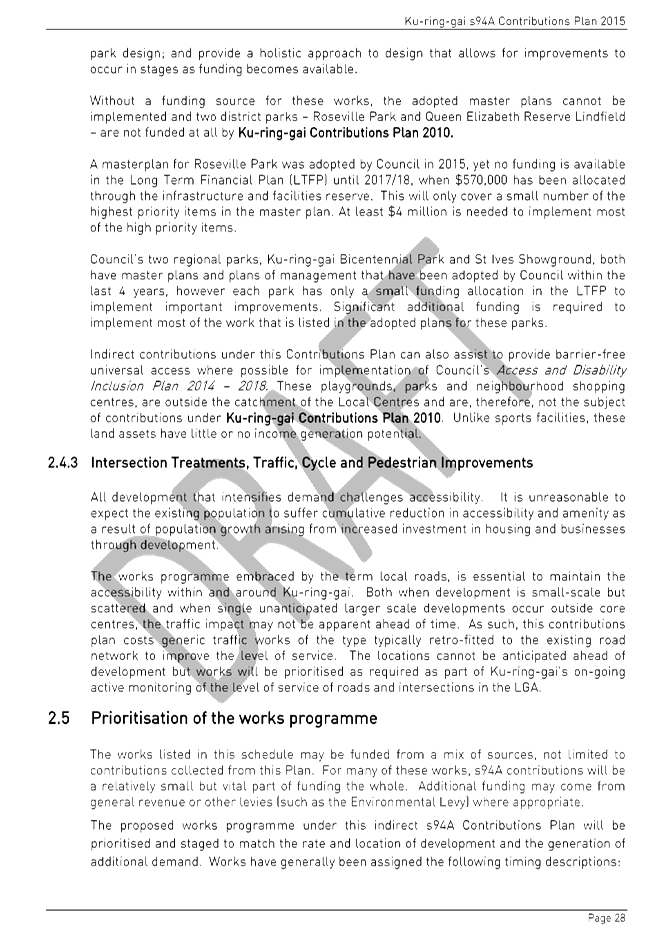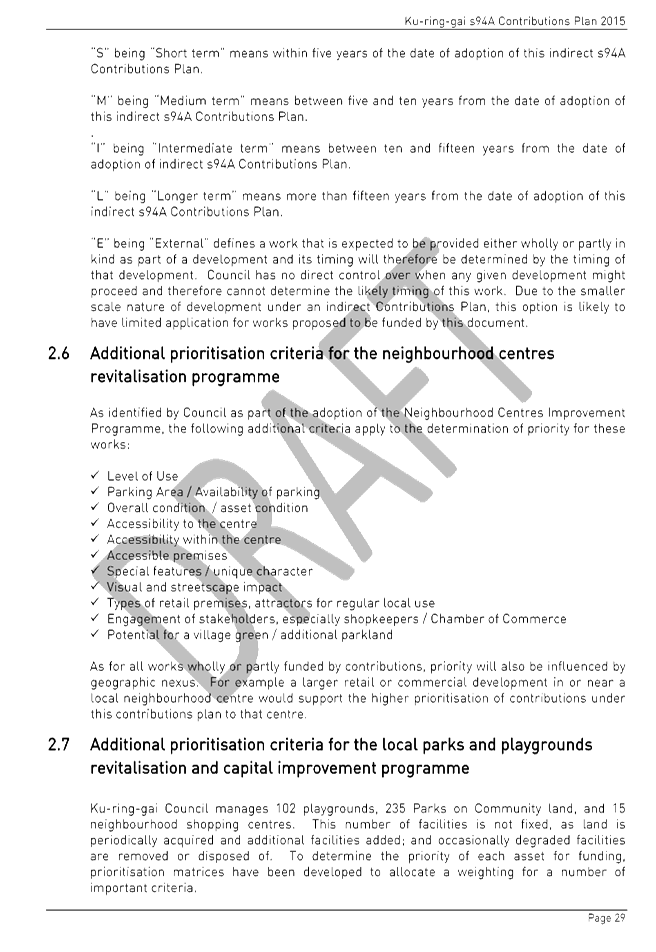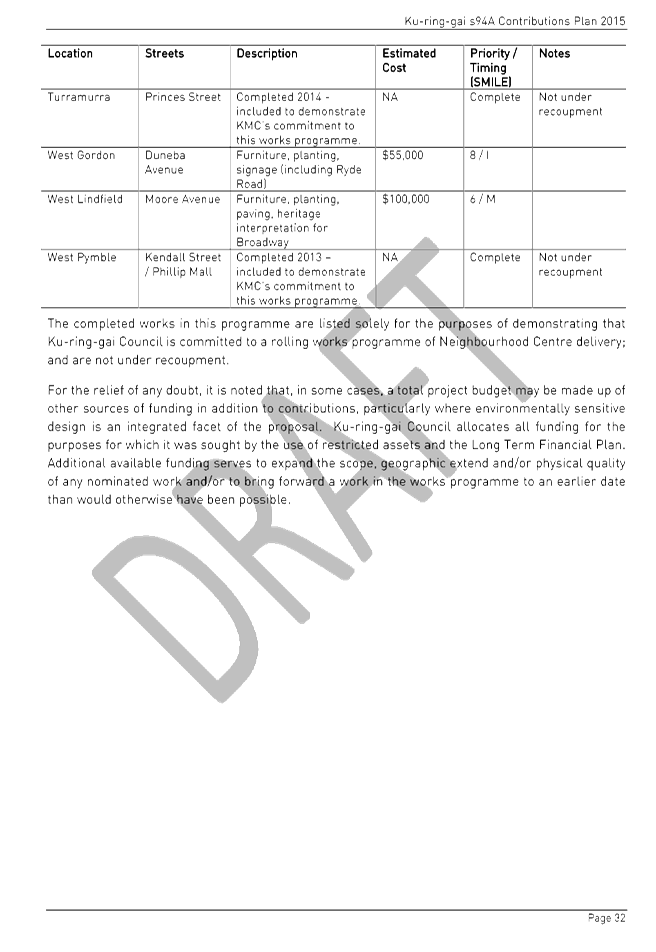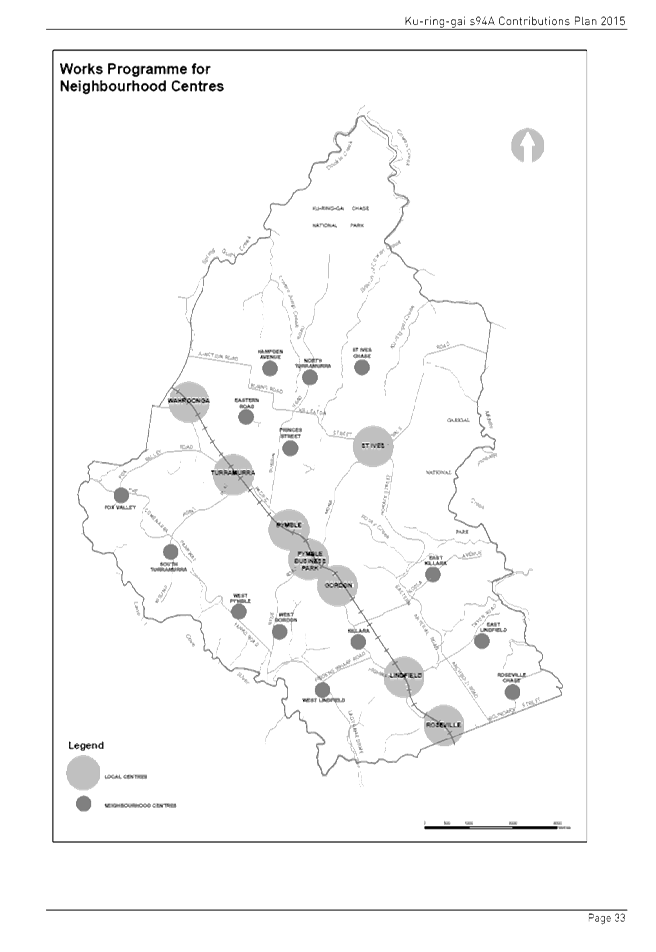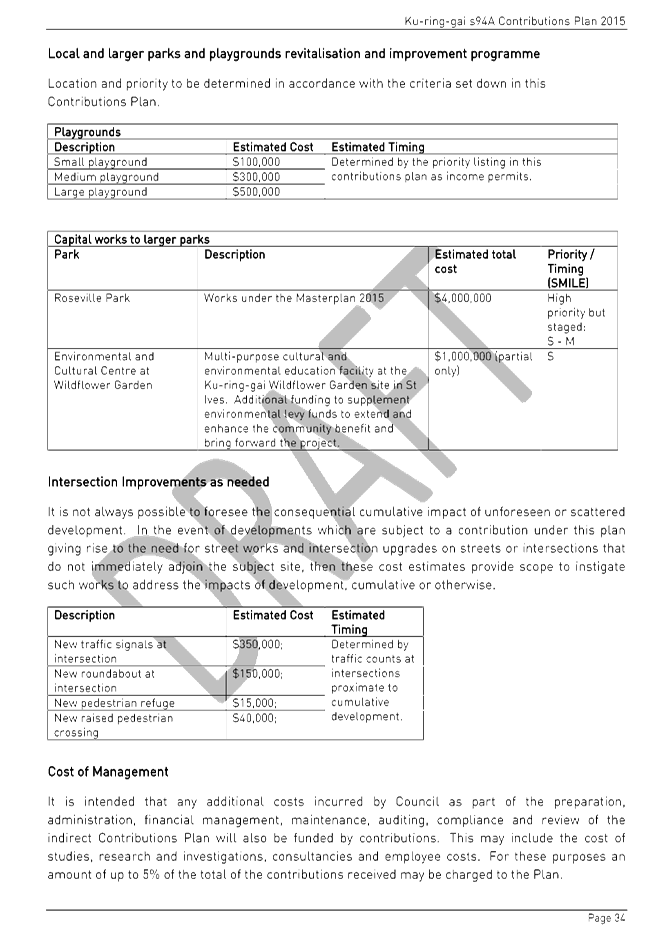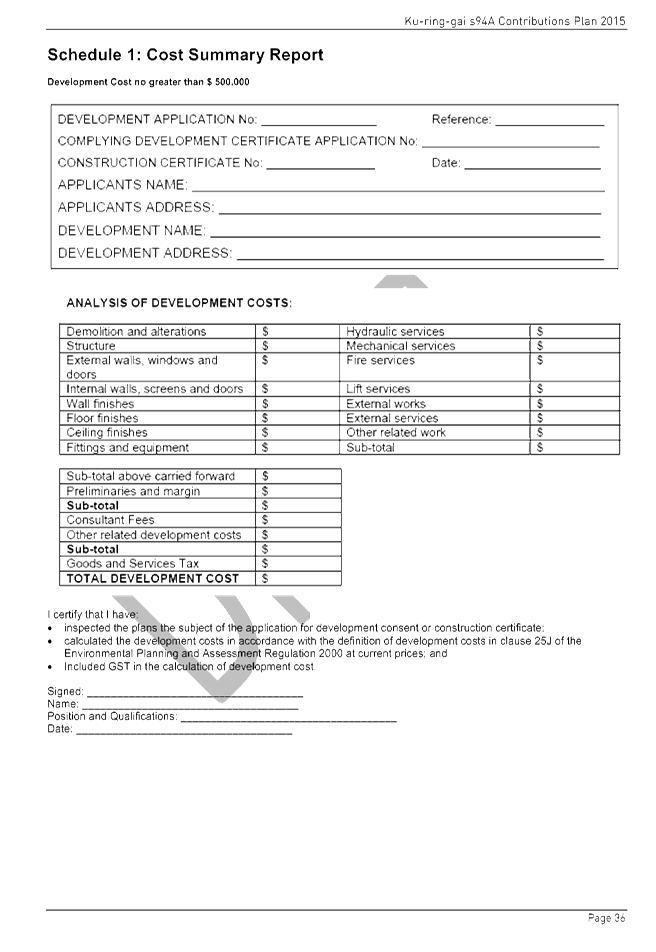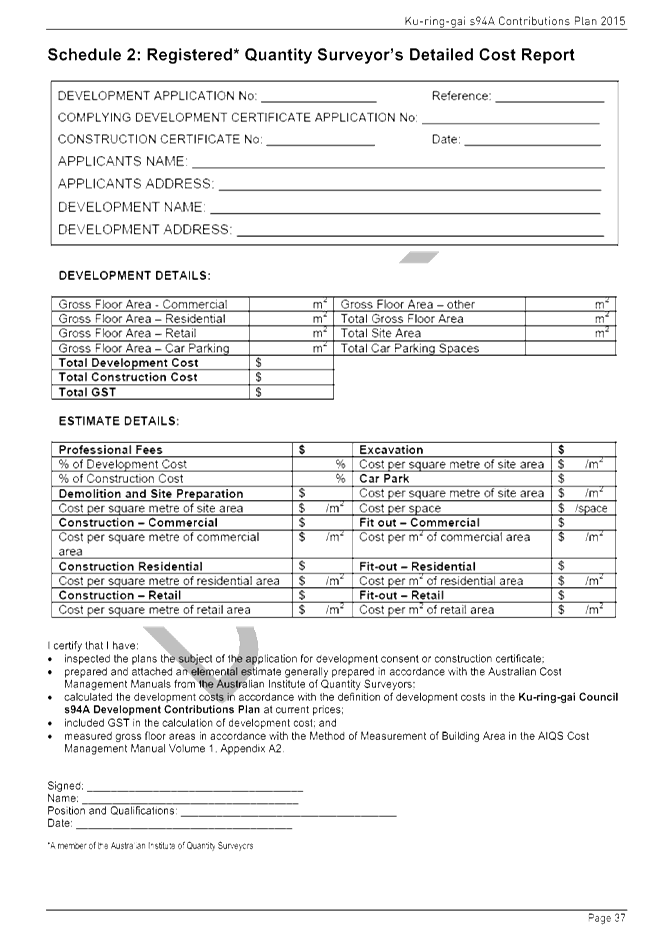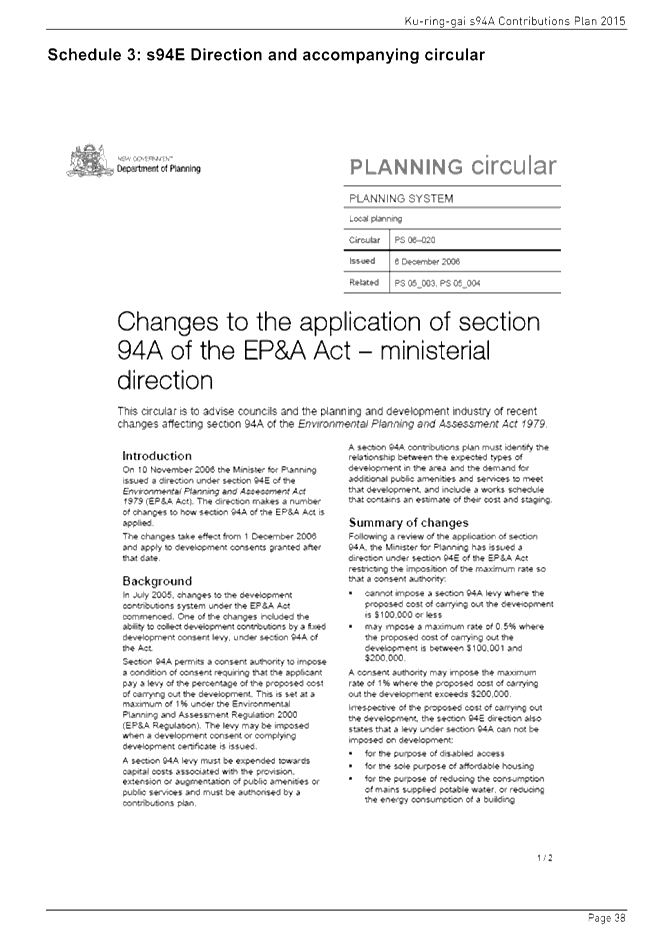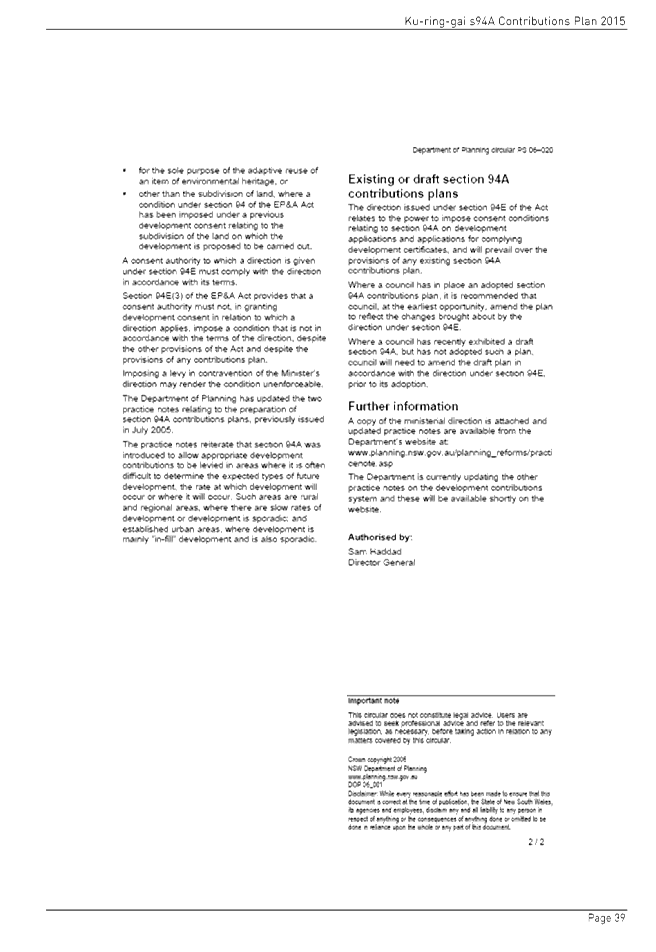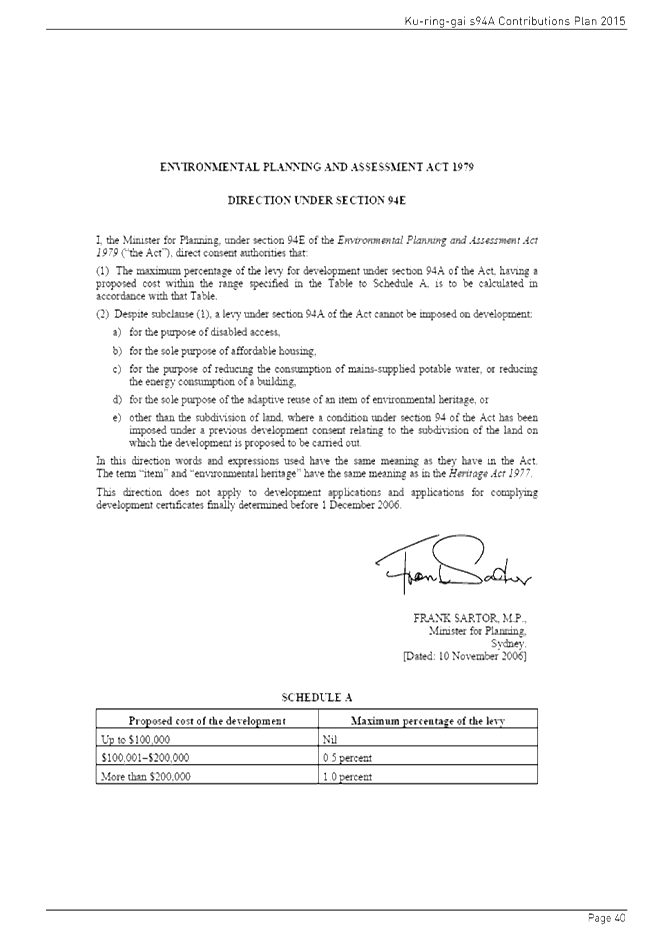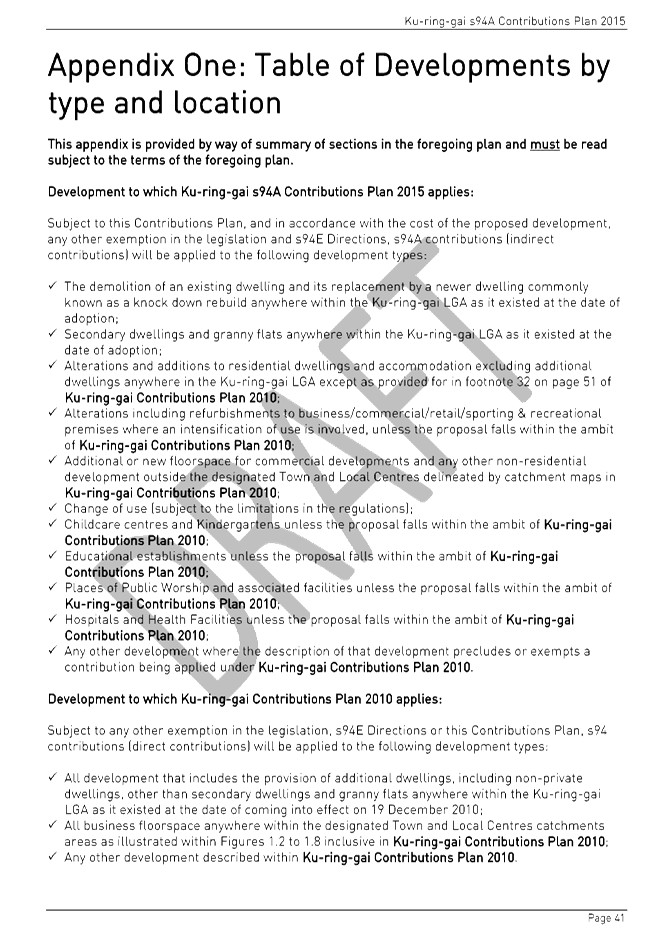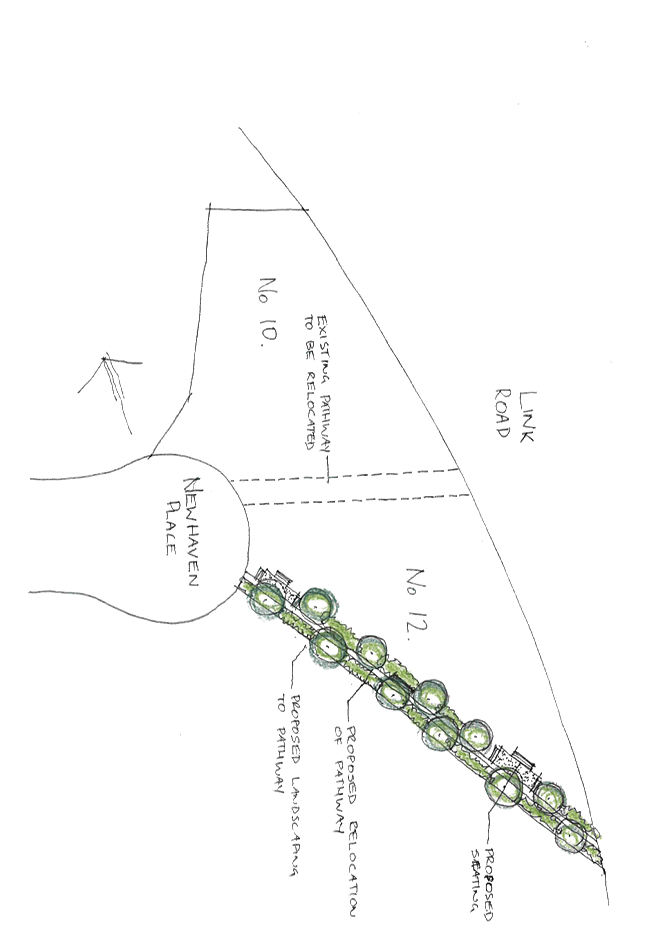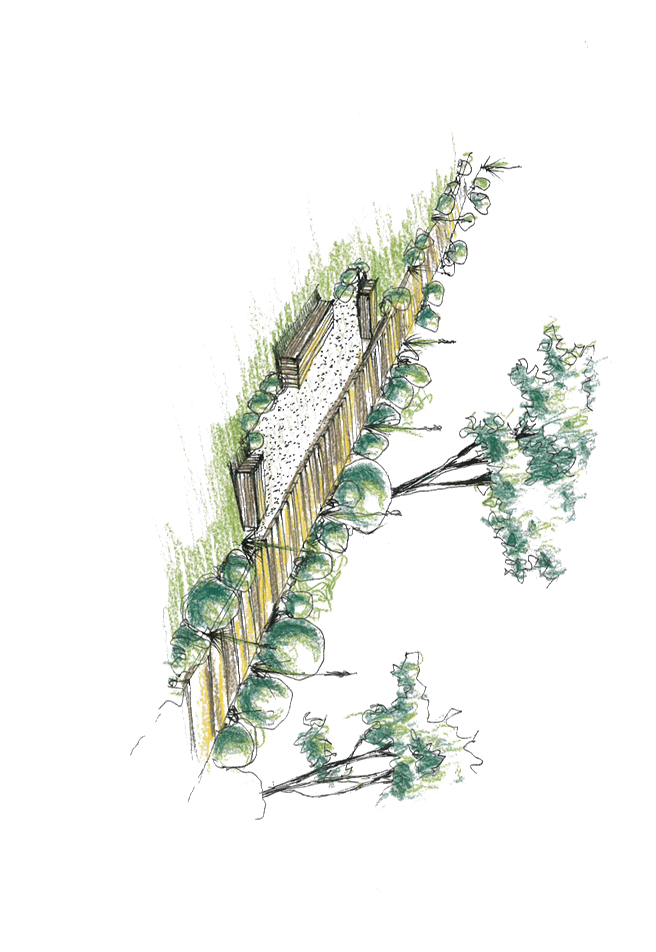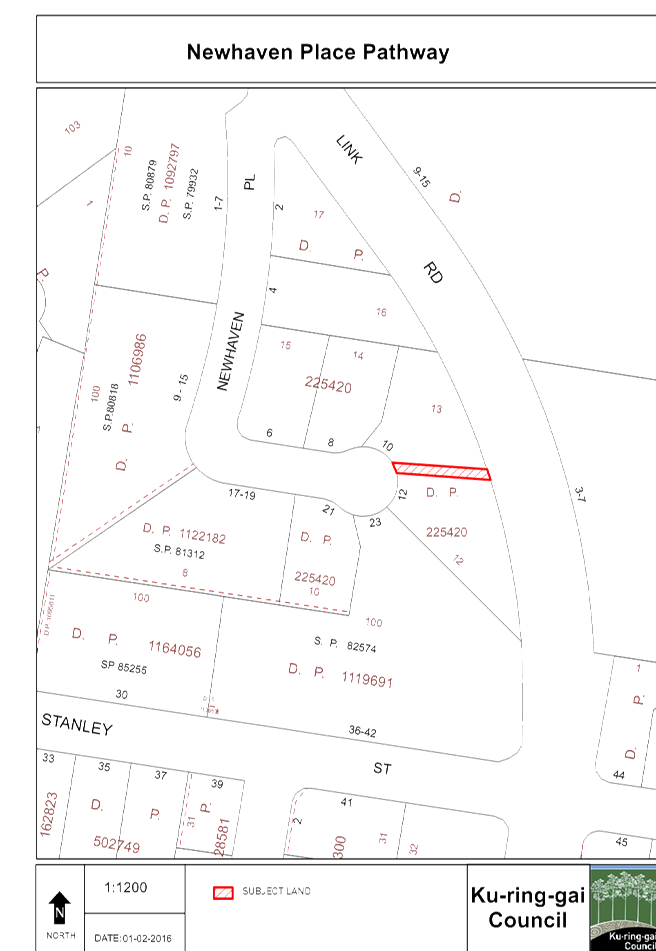|
Resolved:
(Moved: Councillors
McDonald/Fornari-Orsmond)
A. THAT
Council as the consent authority, is satisfied that the requests under Clause
4.6 of Ku-ring-gai Local Centres LEP 2012 to vary the building height and
floor space ratio development standards are well founded. Council is also
satisfied that the proposed development will be in the public interest and is
consistent with the objectives of the development standards and the R4 High
Density Residential zoning.
B. THAT
Council as the consent authority, grant consent to Development Application
No. 0162/15 for demolition of existing structures and construction of a
residential flat building comprising 54 units, basement parking and
associated landscaping works on land at 9 – 17 Eastern Road,
Turramurra.
SCHEDULE A -
Deferred commencement condition
Evidence
required to satisfy the following condition must be submitted to Council
within twelve (12) months of the date of this consent.
This consent does not
operate until the following deferred commencement condition has been
satisfied:
1. Drainage easement (deferred
commencement)
The applicant
shall submit documentary evidence that the property benefits from a drainage
easement over the downstream properties as far as the public drainage system.
This consent will not operate until the documentary evidence has been
submitted to and approved by Council’s Development Engineer.
Reason: To
ensure that provision is made for stormwater drainage from the site in a
proper manner that protects adjoining properties.
Upon receipt of
written notification from Council that the abovementioned condition has been
satisfied, the consent becomes operational and the following conditions will
apply:
SCHEDULE B - The
standard conditions of consent are set out as follows:
Conditions
that identify approved plans:
1. Approved architectural plans
and documentation (new development)
The development must be carried out in accordance with
the following plans and documentation listed below and endorsed with
Council’s stamp, except where amended by other conditions of this
consent:
|
Plan no.
|
Drawn by
|
Dated
|
|
DA0.01 Site Plan
|
RotheLowman
|
05.05.15
|
|
DA0.02 Deep Soil Plans Revision A
|
RotheLowman
|
01.09.15
|
|
DA0.03 Proposed Deep Soil (A2) Revision A
|
RotheLowman
|
01.09.15
|
|
DA0.04 Environmental Site Management Plan
|
RotheLowman
|
01.09.15
|
|
DA0.05 Sediment and Erosion Details
|
RotheLowman
|
01.09.15
|
|
DA1.01 Basement 2 Plan Revision A
|
RotheLowman
|
01.09.15
|
|
DA1.02 Basement 1 Plan Revision B
|
RotheLowman
|
11.09.15
|
|
DA1.03 Ground Floor Revision B
|
RotheLowman
|
11.09.15
|
|
DA1.04 Level 1
|
RotheLowman
|
05.05.15
|
|
DA1.05 Level 2
|
RotheLowman
|
05.05.15
|
|
DA1.06 Level 3 Revision A
|
RotheLowman
|
01.09.15
|
|
DA1.07 Level 4 Revision A
|
RotheLowman
|
01.09.15
|
|
DA1.08 Roof Plan
|
RotheLowman
|
05.05.15
|
|
DA2.01 Elevations 1/4
|
RotheLowman
|
05.05.15
|
|
DA2.02 Elevations 2/4
|
RotheLowman
|
05.05.15
|
|
DA2.03 Elevations 3/4
|
RotheLowman
|
05.05.15
|
|
DA2.04 Elevations 4/4 Revision A
|
RotheLowman
|
01.09.15
|
|
DA2.04 Streetscape Elevation
|
RotheLowman
|
05.05.15
|
|
DA3.02 Section 1/3
|
RotheLowman
|
05.05.15
|
|
DA3.03 Section 2/3
|
RotheLowman
|
05.05.15
|
|
DA3.04 Section 3/3
|
RotheLowman
|
05.05.15
|
|
DA3.05 Section - Lifts
|
RotheLowman
|
01.09.15
|
|
DA3.06 Section - Driveway
|
RotheLowman
|
01.09.15
|
|
DA4.09 Storage Plan 1/2
|
RotheLowman
|
05.05.15
|
|
DA4.10 Storage Plan 2/2
|
RotheLowman
|
05.05.15
|
|
DA5.01 Adaptable Units Plan 1/3
|
RotheLowman
|
05.05.15
|
|
DA5.02 Adaptable Units Plan 2/3
|
RotheLowman
|
05.05.15
|
|
DA5.03 Adaptable Units Plan 3/3
|
RotheLowman
|
05.05.15
|
|
DA7.01 Details - Mailboxes
|
RotheLowman
|
01.09.15
|
|
LDA-000 Landscape Cover Sheet & Design Statement
Revision B
|
Groundink
|
02.09.15
|
|
LDA-001 Landscape Coloured Plan Revision B
|
Groundink
|
02.09.15
|
|
LDA-002 Detailed Landscape Plan Revision B
|
Groundink
|
02.09.15
|
|
LDA-003 Section A Revision B
|
Groundink
|
02.09.15
|
|
LDA-004 Section B Revision B
|
Groundink
|
02.09.15
|
|
LDA-005 Section C Revision B
|
Groundink
|
02.09.15
|
|
LDA-006 Section D Revision B
|
Groundink
|
02.09.15
|
|
LDA-007 Section E Revision B
|
Groundink
|
02.09.15
|
|
LDA-008 Section F Revision B
|
Groundink
|
02.09.15
|
|
LDA-009 Section G Revision B
|
Groundink
|
02.09.15
|
|
LDA-010 Typical Landscape Details Revision B
|
Groundink
|
02.09.15
|
|
LDA-011 Planting Schedule & Existing Tree Schedule
Revision B
|
Groundink
|
02.09.15
|
|
LDA-012 Planting Imagery Revision B
|
Groundink
|
02.09.15
|
|
1.01 Cover Sheet Issue A
|
Acor Consultants
|
17.02.15
|
|
1.02 Stream Flow Controls Investigation Section 1.1 -
1.3 Issue A
|
Acor Consultants
|
17.02.15
|
|
1.03 Stream Flor Controls Investigation Section 1.3-1.4
Issue A
|
Acor Consultants
|
17.02.15
|
|
1.04 Stormwater Quality Investigation Section 2.1-2.2
Issue A
|
Acor Consultants
|
17.02.15
|
|
1.05 Stormwater Quality Investigation Section 2.3-2.4
Issue A
|
Acor Consultants
|
17.02.15
|
|
1.06 Stormwater Quality Investigation Section 2.4-2.5
Issue A
|
Acor Consultants
|
17.02.15
|
|
1.07 Stormwater Quality Investigation Section 2.6 Issue
A
|
Acor Consultants
|
17.02.15
|
|
Sheet 01 Small Rigid Vehicle - Waste Collection
Revision A
|
TEF Consulting
|
01/09/2015
|
|
Sheet 02 Indicative Traffic Management Plan Revision A
|
TEF Consulting
|
01/09/2015
|
|
C1 Cover Sheet & Notes Issue C
|
Acor Consultants
|
28.04.15
|
|
C2 Basement 2 Stormwater Management Plan Issue C
|
Acor Consultants
|
28.04.15
|
|
C3 Basement 1 Stormwater Management Plan Issue E
|
Acor Consultants
|
27.08.15
|
|
C4 Stormwater Management Plan Details Sheet No.1 Issue
E
|
Acor Consultants
|
27.08.15
|
|
C5 Stormwater Management Plan Details Sheet No. 2 Issue
C
|
Acor Consultants
|
28.04.15
|
|
C6 Pump Out Tank Details Issue C
|
Acor Consultants
|
28.04.15
|
|
Document(s)
|
Dated
|
|
3.02 Material Palette (RotheLowman)
|
05-05-2015
|
|
Basix certificate No. 625210M_02
|
21 September 2015
|
|
Arboricultural Report Report Ref: CIA-CVT 02/15 (NSW
Tree Services Pty Ltd)
|
25 February 2015
|
|
Arboricultural Assessment Root Exploration Report
RER-CHV 010/15
|
6 October 2015
|
|
Accessibility Report (ABE Consulting)
|
28 April 2015
|
|
Acoustic Report 27691-SYD-N (Wood & Grieve
Engineers)
|
28/04/15
|
|
BCA Capability Report (Modern Building Certifiers)
|
24 March 2015
|
|
Crime Risk Assessment Report (Harris Crime Prevention
Services)
|
9 September 2015
|
|
Geotechnical Report E22525GA (Environmental
Investigations)
|
14 May 2015
|
|
Heritage Impact Statement (Urbis)
|
April 2015
|
|
SEPP 65 Design Verification Statement (RotheLowman)
|
22-04-2015
|
|
Traffic Impact Statement (TEF Consulting)
|
21/04/15
|
|
Waste Management Plan (unknown)
|
Received by Council 8 May 2015
|
Reason: To ensure that
the development is in accordance with the determination.
2. Inconsistency between
documents
In the event of any inconsistency between conditions of
this consent and the drawings/documents referred to above, the conditions of
this consent prevail.
Reason: To ensure that
the development is in accordance with the determination.
Conditions
to be satisfied prior to demolition, excavation or construction:
3. Asbestos works
All work involving asbestos products and materials,
including asbestos-cement-sheeting (ie. Fibro), must be carried out in
accordance with the guidelines for asbestos work published by WorkCover
Authority of NSW.
Reason: To
ensure public safety.
4. Notice
of commencement
At least 48
hours prior to the commencement of any development (including demolition,
excavation, shoring or underpinning works), a notice of commencement of
building or subdivision work form and appointment of the principal certifying
authority form shall be submitted to Council.
Reason: Statutory requirement.
5. Notification
of builder’s details
Prior to the commencement of any development or
excavation works, the Principal Certifying Authority shall be notified in
writing of the name and contractor licence number of the owner/builder
intending to carry out the approved works.
Reason: Statutory
requirement.
6. Dilapidation
survey and report (public infrastructure)
Prior to the
commencement of any development or excavation works on site, the Principal
Certifying Authority shall be satisfied that a dilapidation report on the visible
and structural condition of all structures of the following public
infrastructure, has been completed and submitted to Council:
Public
infrastructure
· Full road pavement width, including kerb and gutter, of Eastern
Road over the site frontage.
· All driveway crossings and laybacks opposite the subject site.
The report
must be completed by a consulting structural/civil engineer. Particular
attention must be paid to accurately recording (both written and
photographic) existing damaged areas on the aforementioned infrastructure so
that Council is fully informed when assessing any damage to public
infrastructure caused as a result of the development.
The developer
may be held liable to any recent damage to public infrastructure in the
vicinity of the site, where such damage is not accurately recorded by the
requirements of this condition prior to the commencement of works.
Note: A
written acknowledgment from Council must be obtained (attesting to this
condition being appropriately satisfied) and submitted to the Principal
Certifying Authority prior to the commencement of any excavation works.
Reason: To
record the structural condition of public infrastructure before works
commence.
7. Dilapidation
survey and report (private property)
Prior to the commencement
of any demolition or excavation works on site, the Principal Certifying
Authority shall be satisfied that a dilapidation report on the visible and
structural condition of all structures upon the following lands, has been
completed and submitted to Council:
|
Address
|
|
· 17a Eastern Road
|
|
|
The
dilapidation report must include a photographic survey of adjoining
properties detailing their physical condition, both internally and
externally, including such items as walls ceilings, roof and structural
members. The report must be completed by a consulting structural/geotechnical
engineer as determined necessary by that professional based on the
excavations for the proposal and the recommendations of the submitted
geotechnical report.
In the event
that access for undertaking the dilapidation survey is denied by a property
owner, the applicant must demonstrate in writing to the satisfaction of the
Principal Certifying Authority that all reasonable steps have been taken to
obtain access and advise the affected property owner of the reason for the
survey and that these steps have failed.
Note: A
copy of the dilapidation report is to be provided to Council prior to any
excavation works been undertaken. The dilapidation report is for record
keeping purposes only and may be used by an applicant or affected property
owner to assist in any civil action required to resolve any dispute over
damage to adjoining properties arising from works.
Reason: To
record the structural condition of likely affected properties before works
commence.
8. Geotechnical
report
Prior to the
commencement of any bulk excavation works on site, the applicant shall submit
to the Principal Certifying Authority, the results of the detailed
geotechnical investigation comprising a minimum of two cored boreholes to at
least 3 metre below the proposed basement level. The report is to address
such matters as:
· appropriate excavation methods and techniques
· vibration management and monitoring
· dilapidation survey
· support and retention of excavates faces
· hydrogeological considerations
The
recommendations of the report are to be implemented during the course of the
works.
Reason: To
ensure the safety and protection of property.
9. Access
through public reserve not permitted
Access for
construction purposes shall not be gained through the adjoining public
reserve. Should no alternative access exist, an application for access
to the construction site via the public reserve shall be submitted to Council
for consideration and approval prior to the commencement of works.
Reason: To
protect public reserves.
10. Construction
and traffic management plan
The applicant
must submit to Council a Construction Traffic Management Plan (CTMP), which
is to be approved prior to the commencement of any works on site.
The plan is
to consist of a report with Traffic Control Plans attached.
The report is
to contain commitments which must be followed by the demolition and
excavation contractor, builder, owner and subcontractors. The CTMP
applies to all persons associated with demolition, excavation and
construction of the development.
The report is
to contain construction vehicle routes for approach and departure to and from
all directions.
The report is
to contain a site plan showing entry and exit points. Swept paths are
to be shown on the site plan showing access and egress for an 11 metre long
heavy rigid vehicle.
The Traffic
Control Plans are to be prepared by a qualified person (red card
holder). One must be provided for each of the following stages of the
works:
o Demolition
o Excavation
o Concrete
pour
o Construction
of vehicular crossing and reinstatement of footpath
o Traffic
control for vehicles reversing into or out of the site.
Traffic
controllers must be in place at the site entry and exit points to control
heavy vehicle movements in order to maintain the safety of pedestrians and
other road users.
When a
satisfactory CTMP is received, a letter of approval will be issued with
conditions attached. Traffic management at the site must comply with
the approved CTMP as well as any conditions in the letter issued by
Council. Council’s Rangers will be patrolling the site regularly
and fines may be issued for any non-compliance with this condition.
Reason: To
ensure that appropriate measures have been considered during all phases of
the construction process in a manner that maintains the environmental amenity
and ensures the ongoing safety and protection of people.
11. Work
zone
A Works Zone
is to be provided in Eastern Road subject to the approval of the Ku-ring-gai
Local Traffic Committee.
No loading or
unloading must be undertaken from the public road or nature strip unless
within a Works Zone which has been approved and paid for.
In the event
the work zone is required for a period beyond that initially approved by the
Traffic Committee, the applicant shall make a payment to Council for the
extended period in accordance with Council’s schedule of fees and
charges for work zones prior to the extended period commencing.
Reason: To
ensure that appropriate measures have been made for the operation of the site
during the construction phase.
12. Erosion
and drainage management
Earthworks
and/or demolition of any existing buildings shall not commence until an
erosion and sediment control plan is submitted to and approved by the
Principal Certifying Authority. The plan shall comply with the
guidelines set out in the NSW Department of Housing manual "Managing
Urban Stormwater: Soils and Construction". Erosion and sediment control
works shall be implemented in accordance with the erosion and sediment
control plan.
Reason: To
preserve and enhance the natural environment.
13. Tree protection
fencing
To preserve the following tree/s, no work shall commence
until the area beneath their canopy is fenced off at the specified radius
from the trunk/s to prevent any activities, storage or the disposal of
materials within the fenced area. The fence/s shall be maintained intact
until the completion of all demolition/building work on site.
|
Schedule
|
|
Tree/Location
|
Radius in metres
|
|
|
Tree 1/ Jacaranda mimosifolia (Jacaranda) This
mature tree is located at the south-east corner of the site
|
7.0m
|
|
|
Tree 9/ Lophostemon confertus (Brushbox) This
mature tree is located north of the proposed driveway within the nature
strip
|
9.2m
|
|
|
Tree 15/ Elaeocarpus reticulatus (Blueberry Ash)
This tree is located on the southern boundary
|
7.2m
|
|
|
Syzygium paniculatum (Brush Cherry) This mature tree is located at the
south-east corner of the site, within the adjoining property
|
7.0m
|
|
Reason: To
protect existing trees during the construction phase.
14. Tree protection fencing excluding
structure
To preserve the following tree/s, no work shall commence
until the area beneath their canopy excluding that area of the approved
driveway shall be fenced off for the specified radius from the trunk to
prevent any activities, storage or the disposal of materials within the
fenced area. The fence/s shall be maintained intact until the
completion of all demolition/building work on site:
|
Schedule
|
|
Tree/Location
|
Radius from trunk
|
|
Tree 7/ Lophostemon confertus (Brushbox) This
mature tree is located south of the proposed driveway within the nature
strip
|
8.0m
|
Reason: To
protect existing trees during the construction phase.
15. Tree protective fencing type galvanised
mesh
The tree protection fencing shall be constructed of
galvanised pipe at 2.4 metre spacing and connected by securely attached chain
mesh fencing to a minimum height of 1.8 metres in height prior to work
commencing.
Reason: To protect existing trees during construction
phase.
16. Tree protection signage
Prior to works commencing, tree protection signage is to
be attached to each tree protection zone, displayed in a prominent position
and the sign repeated at 10 metres intervals or closer where the fence
changes direction. Each sign shall contain in a clearly legible form,
the following information:
Tree protection zone.
· This fence has been installed to prevent
damage to the trees and their growing environment both above and below ground
and access is restricted.
· Any encroachment not previously approved
within the tree protection zone shall be the subject of an arborist's report.
· The arborist's report shall provide proof that
no other alternative is available.
· The Arborist's report shall be submitted to
the Principal Certifying Authority for further consultation with Council.
· The name, address, and telephone number of the
developer.
Reason: To protect
existing trees during the construction phase.
17. Tree fencing inspection
Upon installation of the required tree protection
measures, an inspection of the site by the Principal Certifying Authority is
required to verify that tree protection measures comply with all relevant
conditions.
Reason: To
protect existing trees during the construction phase.
18. CCTV
report of existing Council pipe system near works
Prior to the
commencement of any works on site, qualified practitioners must undertake a
closed circuit television inspection and then report on the existing
condition of the Council drainage pipeline traversing the subject property. The
report must be provided to Council’s, Development Engineer and is to
include a copy of the video footage of the pipeline. A written acknowledgment
from Council’s Development Engineer (attesting to this condition being
appropriately satisfied) shall be obtained and submitted to the Principal
Certifying Authority prior to the commencement of any works on site.
Reason: To
protect Council’s infrastructure.
Conditions
to be satisfied prior to the issue of the construction certificate:
19. Private
courtyards
Prior to the
issue of a Construction Certificate the Landscape Plans LDA-001 and LDA-002
and Drawing D1.03 Ground Floor Revision A shall be amended so that the
private courtyards of Apartments 001, 002, 003 and 006 achieve a 8 metres
setback from the front boundary. Amended plans and specifications are to be
submitted to the Principal Certifying Authority prior to the issue of a
Construction Certificate.
Reason: To achieve the desired landscape outcome within the front setback.
20. Amendments to approved landscape plan
Prior to the issue of a Construction Certificate, the
Certifying Authority shall be satisfied that the approved landscape plans,
listed below and endorsed with Council’s stamp, have been amended in
accordance with the requirements of this condition as well as other
conditions of this consent:
|
Plan no.
|
Title
|
Drawn by
|
Dated
|
|
LDA-001 to LDA-011 Revision B
|
Landscape Plans and associated documentation
|
Groundink
|
2/09/15
|
The above landscape plan(s) shall be amended in the following
ways:
1. The
plans are to be in accordance with amended architectural plans and as per
relevant conditions.
2. To achieve the
landscape objectives the private courtyards to Apartments 1, 2, 3 and 6 are
to be reduced in size so that they do not encroach within 8 metres of the
front boundary.
3. Tree
numbers are to be shown on the Detailed Landscape Plan.
4. The
existing mature Syzigium is incorrectly shown on the detailed
landscape plan. The following tree is to be accurately shown on the landscape
plan and a notation added requiring existing levels to be retained within
approximately 2.5m of the site boundary within the tree protection zone, Syzygium
paniculatum (Brush Cherry) This mature tree is located within the
adjoining property, no 10 Gilroy Street Turramurra, towards the southeast
corner.
5. The
proposed retaining wall along the southern boundary is to follow the
alignment of the existing concrete retaining wall within the tree protection
zone of Tree 2 to ensure excavation within the structural root zone is
avoided.
6. The
rear communal open space is to be connected to the fire access within
southern setback to Eastern Road.
7. The
drainage pits and tanks should be shown.
8. Planting
between the private courtyard fence of Apartments 3 and 6 and the entry
ramp is to be provided within the common area.
9. Without
external access the proposed lawn areas within Apartments 1,2 3,6,8 and 9 are
to be substituted with groundcover plants.
10. Proposed
planting of Robinia pseudoacacia (Black Locust) are to be substituted
with a canopy tree species that is protected under Council’s DCP such
as Gleditsia triacanthos (Honey Locust) or similar.
11. The
proposed planting of Morus nigra and Mangifera indica along the
site boundary to the eastern elevation of the building are to be substituted
or planted in associated with tall tree planting such as Pyrus calleryana
or similar.
Prior to the issue of the Construction Certificate, the
Principal Certifying Authority shall be satisfied that the amended landscape
plan has been submitted as required by this condition.
Note: An
amended landscape plan shall be submitted to the Certifying Authority.
Reason: To ensure that
the development is in accordance with the determination.
21. Amendments to approved architectural
plans
Prior to the issue of a Construction Certificate, the
Certifying Authority shall be satisfied that the approved architectural
plans, listed below and endorsed with Council’s stamp, have been
amended in accordance with the requirements of this condition as well as
other conditions of this consent:
|
Plan no.
|
Title
|
Drawn by
|
Dated
|
|
DA1.03 Rev A
|
Ground Floor Plan and all other relevant plans and
sections
|
Rothe Lowman
|
1/09/15
|
The above architectural plan(s) shall be amended in the
following ways:
1. To achieve the
landscape objectives the private courtyards to Apartments 1, 2, 3 and 6 are
to be reduced in size so that they do not encroach within 8 metres of the
front boundary.
2. To
preserve the health and condition of the following trees, the proposed
location of the fire hydrant as well as the water and gas mains at the
southwest corner of the site are to be relocated so that they are not within
the specified radius of the following trees,
|
Schedule
|
|
Tree/Location
|
Radius from trunk
|
|
Tree 7/ Lophostemon confertus (Brushbox) This
mature tree is located south of the proposed driveway within the nature
strip
|
4.0m
|
|
Tree 9/ Lophostemon confertus (Brushbox) This
mature tree is located north of the proposed driveway within the nature
strip
|
6m
|
Prior to the issue of the Construction Certificate, the
Principal Certifying Authority shall be satisfied that the amended architectural
plan has been submitted as required by this condition.
Note: An
amended architectural plan shall be submitted to the Certifying Authority.
Reason: To ensure that
the development is in accordance with the determination.
22. Amendments
to approved engineering plans
Prior to the issue of a Construction Certificate, the
Certifying Authority shall be satisfied that the approved engineering
plan(s), listed below and endorsed with Council’s stamp, have been
amended in accordance with the requirements of this condition as well as
other conditions of this consent:
|
Plan no.
|
Drawn by
|
Dated
|
|
GO150052 C3 Issue E
|
ACOR Consultants
|
27.08.15
|
The above engineering plan(s) shall be amended as
follows:
A sealed junction pit is to be constructed at the point
of connection of the property stormwater system to Council's trunk drainage
pipeline.
Note: An
amended engineering plan, prepared by a qualified engineer shall be submitted
to the Certifying Authority.
Reason: To ensure that
the development is in accordance with the determination.
23. Long
service levy
In accordance
with Section 109F(i) of the Environmental Planning and Assessment Act a
Construction Certificate shall not be issued until any long service levy
payable under Section 34 of the Building and Construction Industry Long
Service Payments Act 1986 (or where such levy is payable by instalments, the
first instalment of the levy) has been paid. Council is authorised to accept
payment. Where payment has been made elsewhere, proof of payment is to be
provided to Council.
Reason: Statutory
requirement.
24. Builder’s
indemnity insurance
The
applicant, builder, developer or person who does the work on this
development, must arrange builder’s indemnity insurance and submit the
certificate of insurance in accordance with the requirements of Part 6 of the
Home Building Act 1989 to the Certifying Authority for endorsement of the
plans accompanying the Construction Certificate.
It is the
responsibility of the applicant, builder or developer to arrange the
builder's indemnity insurance for residential building work over the value of
$20,000. The builder's indemnity insurance does not apply to commercial or
industrial building work or to residential work valued at less than $20,000,
nor to work undertaken by persons holding an owner/builder's permit issued by
the Department of Fair Trading (unless the owner/builder's property is sold
within 7 years of the commencement of the work).
Reason: Statutory
requirement.
25. External
service pipes and the like prohibited
Proposed
water pipes, waste pipes, stack work, duct work, mechanical ventilation plant
and the like must be located within the building. Details confirming
compliance with this condition must be shown on construction certificate
plans and detailed with construction certificate specifications.
Required external vents or vent pipes on the roof or above the eaves must be
shown on construction certificate plans and detailed with construction
certificate specifications. External vents or roof vent pipes must not
be visible from any place unless detailed upon development consent
plans. Where there is any proposal to fit external service pipes or the
like this must be detailed in an amended development (S96) application and
submitted to Council for determination.
Vent pipes
required by Sydney Water must not be placed on the front elevation of the
building or front roof elevation. The applicant, owner and builder must
protect the appearance of the building from the public place and the
appearance of the streetscape by elimination of all external services
excluding vent pipes required by Sydney Water and those detailed upon
development consent plans.
Reason: To protect the streetscape and the integrity of the
approved development.
26. Access
for people with disabilities (residential)
Prior to the
issue of the Construction Certificate, the Certifying Authority shall be
satisfied that access for people with disabilities to and from and between
the public domain, residential units and all common open space areas is
provided. Consideration must be given to the means of dignified and equitable
access.
Compliant
access provisions for people with disabilities shall be clearly shown on
the plans submitted with the Construction Certificate. All
details shall be provided to the Principal Certifying Authority prior to the
issue of the Construction Certificate. All details shall be prepared in
consideration of the Disability Discrimination Act, and the relevant
provisions of AS1428.1, AS1428.2, AS1428.4 and AS 1735.12.
Reason: To
ensure the provision of equitable and dignified access for all people in
accordance with disability discrimination legislation and relevant Australian
Standards.
27. Adaptable
units
Prior to the issue of the Construction Certificate, the Certifying
Authority shall be satisfied that the nominated adaptable units within the
development application, [004, 012,104,204, 304, 406], are designed as
adaptable housing in accordance with the provisions of Australian Standard
AS4299-1995: Adaptable Housing.
Note: Evidence
from an appropriately qualified professional demonstrating compliance with
this control is to be submitted to and approved by the Certifying Authority
prior to the issue of the Construction Certificate.
Reason: Disabled access & amenity.
28. Excavation for services
Prior to the issue of the Construction Certificate, the
Principal Certifying Authority shall be satisfied that no proposed
underground services (ie: water, sewerage, drainage, gas or other service)
unless previously approved by conditions of consent, are located beneath the
canopy of any tree protected under Council’s Tree Preservation Order,
located on the subject allotment and adjoining allotments.
Note: A
plan detailing the routes of these services and trees protected under the
Tree Preservation Order shall be submitted to the Principal Certifying
Authority.
Reason: To ensure the
protection of trees.
29. Location of plant (residential flat
buildings)
Prior to the
issue of the Construction Certificate, the Certifying Authority shall be
satisfied that all plant and equipment (including but not limited to air
conditioning equipment) is located within the basement.
C1. Note: Architectural
plans identifying the location of all plant and equipment shall be provided
to the Certifying Authority.
Reason: To
minimise impact on surrounding properties, improved visual appearance and
amenity for locality.
30. Driveway
crossing levels
Prior to
issue of the Construction Certificate, driveway and associated footpath
levels for any new, reconstructed or extended sections of driveway crossings
between the property boundary and road alignment must be obtained from
Ku-ring-gai Council. Such levels are only able to be issued by Council under
the Roads Act 1993. All footpath crossings, laybacks and driveways are
to be constructed according to Council's specifications "Construction of
Gutter Crossings and Footpath Crossings".
Specifications
are issued with alignment levels after completing the necessary application
form at Customer Services and payment of the assessment fee. When completing
the request for driveway levels application from Council, the applicant must
attach a copy of the relevant development application drawing which indicates
the position and proposed level of the proposed driveway at the boundary
alignment.
This
development consent is for works wholly within the property. Development
consent does not imply approval of footpath or driveway levels, materials or
location within the road reserve, regardless of whether this information is
shown on the development application plans. The grading of such footpaths or
driveways outside the property shall comply with Council's standard
requirements. The suitability of the grade of such paths or driveways
inside the property is the sole responsibility of the applicant and the
required alignment levels fixed by Council may impact upon these levels.
The
construction of footpaths and driveways outside the property in materials
other than those approved by Council is not permitted.
Reason: To
provide suitable vehicular access without disruption to pedestrian and
vehicular traffic.
31. Driveway
grades - basement carparks
Prior to the
issue of the Construction Certificate, longitudinal driveway sections are to
be prepared by a qualified civil/traffic engineer and be submitted for to and
approved by the Certifying Authority. These profiles are to be at 1:100 scale
along both edges of the proposed driveway, starting from the centreline of
the frontage street carriageway to the proposed basement floor level. The
traffic engineer shall provide specific written certification on the plans
that:
· vehicular access can be obtained using grades of 20% (1 in 5)
maximum and
· all changes in grade (transitions) comply with Australian Standard
2890.1 -“Off-street car parking” (refer clause 2.5.3) to prevent
the scraping of the underside of vehicles.
If a new
driveway crossing is proposed, the longitudinal sections must incorporate the
driveway crossing levels as issued by Council upon prior application.
Reason: To
provide suitable vehicular access without disruption to pedestrian and
vehicular traffic.
32. Basement
car parking details
Prior to
issue of the Construction Certificate, certified parking layout plan(s) to
scale showing all aspects of the vehicle access and accommodation
arrangements must be submitted to and approved by the Certifying Authority. A
qualified civil/traffic engineer must review the proposed vehicle access and
accommodation layout and provide written certification on the plans that:
· all parking space dimensions, driveway and aisle widths, driveway
grades, transitions, circulation ramps, blind aisle situations and other
trafficked areas comply with Australian Standard 2890.1 - 2004
“Off-street car parking”
· a clear height clearance of 2.6 metres is provided over the
designated garbage collection truck manoeuvring areas within the basement
· no doors or gates are provided in the access driveways to the
basement carpark which would prevent unrestricted access for internal garbage
collection at any time from the basement garbage storage and collection area
· the vehicle access and accommodation arrangements are to be
constructed and marked in accordance with the certified plans
Reason: To
ensure that parking spaces are in accordance with the approved development.
33. Car
parking allocation
Car parking
within the development shall be allocated in the following way:
|
Resident
car spaces
|
50
|
|
Visitor
spaces
|
13
|
|
Total
spaces
|
63
|
Each
adaptable dwelling must be provided with car parking complying with the
dimensional and location requirements of AS2890.1 - parking spaces for people
with disabilities.
At least one
visitor space shall also comply with the dimensional and location
requirements of AS2890.1 - parking spaces for people with disabilities.
Consideration
must be given to the means of access from disabled car parking spaces to
other areas within the building and to footpath and roads and shall be
clearly shown on the plans submitted with the Construction Certificate.
Reason: To
ensure equity of access and appropriate facilities are available for people
with disabilities in accordance with federal legislation.
34. Number
of bicycle spaces
The basement
car park shall be adapted to provide 17 bicycle spaces (6 allocated as
visitor spaces) in accordance with 7B.2 Bicycle Parking Provision of
Ku-ring-gai Town Centres DCP. The bicycle parking spaces shall be designed in
accordance with AS2890.3. Details shall be submitted to the satisfaction of
the Certifying Authority prior to the issue of a Construction Certificate.
Reason: To
provide alternative modes of transport to and from the site.
Conditions
to be satisfied prior to the issue of the construction certificate or prior to demolition, excavation
or construction (whichever comes first):
35. Infrastructure
restorations fee
To ensure
that damage to Council Property as a result of construction activity is
rectified in a timely matter:
a) All work or activity
taken in furtherance of the development the subject of this approval must be
undertaken in a manner to avoid damage to Council Property and must not
jeopardise the safety of any person using or occupying the adjacent public
areas.
b) The applicant,
builder, developer or any person acting in reliance on this approval shall be
responsible for making good any damage to Council Property, and for the
removal from Council Property of any waste bin, building materials, sediment,
silt, or any other material or article.
c) The Infrastructure
Restoration Fee must be paid to the Council by the applicant prior to both
the issue of the Construction Certificate and the commencement of any
earthworks or construction.
d) In consideration of
payment of the Infrastructure Restorations Fee, Council will undertake such
inspections of Council Property as Council considers necessary and also
undertake, on behalf of the applicant, such restoration work to Council
Property, if any, that Council considers necessary as a consequence of the
development. The provision of such restoration work by the Council does not absolve
any person of the responsibilities contained in (a) to (b) above. Restoration
work to be undertaken by the Council referred to in this condition is limited
to work that can be undertaken by Council at a cost of not more than the
Infrastructure Restorations Fee payable pursuant to this condition.
e) In this condition:
“Council Property” includes any road, footway,
footpath paving, kerbing, guttering, crossings, street furniture, seats,
letter bins, trees, shrubs, lawns, mounds, bushland, and similar structures
or features on any road or public road within the meaning of the Local
Government Act 1993 (NSW) or any public place; and
“Infrastructure Restoration Fee” means the
Infrastructure Restorations Fee calculated in accordance with the Schedule of
Fees & Charges adopted by Council as at the date of payment and the cost
of any inspections required by the Council of Council Property associated
with this condition.
Reason: To maintain public
infrastructure.
36. Section 94 Contributions - Centres.
(For DAs
determined on or after 19 December 2010)
This development is subject to a development contribution
calculated in accordance with Ku-ring-gai Contributions Plan 2010, being a
s94 Contributions Plan in effect under the Environmental Planning and Assessment
Act, as follows:
|
Key Community Infrastructure
|
Amount
|
|
Local parks and local sporting facilities
|
$617,173.81
|
|
Local recreation and cultural
facilities; Local social facilities
|
$80,926.51
|
|
Local roads, local bus facilities &
local drainage facilities (new roads and road modifications)
|
$142,140.76
|
|
Local roads, local bus facilities &
local drainage facilities (townscape, transport & pedestrian
facilities)
|
$424,025.81
|
|
Total:
|
$1,264,266.89
|
The contribution shall be paid to Council prior to the
issue of any Construction Certificate, Linen Plan, Certificate of Subdivision
or Occupation Certificate whichever comes first in accordance with
Ku-ring-gai Contributions Plan 2010.
The contributions specified above are subject to
indexation and will continue to be indexed to reflect changes in the consumer
price index and housing price index until they are paid in accordance with
Ku-ring-gai Contributions Plan 2010 to reflect changes in the consumer price
index and housing price index. Prior to payment, please contact Council
directly to verify the current payable contributions.
Copies of Council’s Contribution Plans can be
viewed at Council Chambers, 818 Pacific Hwy Gordon or on Council’s
website at www.kmc.nsw.gov.au.
Reason: To ensure the provision, extension or
augmentation of the Key Community Infrastructure identified in Ku-ring-gai
Contributions Plan 2010 that will, or is likely to be, required as a
consequence of the development.
Conditions
to be satisfied during the demolition, excavation and construction phases:
37. Road opening permit
The opening of any footway, roadway, road
shoulder or any part of the road reserve shall not be carried out without a
road opening permit being obtained from Council (upon payment of the required
fee) beforehand.
Reason: Statutory
requirement (Roads Act 1993 Section 138) and to maintain the integrity of
Council’s infrastructure.
38. Prescribed
conditions
The applicant
shall comply with any relevant prescribed conditions of development consent
under clause 98 of the Environmental Planning and Assessment Regulation. For
the purposes of section 80A (11) of the Environmental Planning and Assessment
Act, the following conditions are prescribed in relation to a development
consent for development that involves any building work:
· The work must be carried out in accordance with the requirements
of the Building Code of Australia
· In the case of residential building work for which the Home
Building Act 1989 requires there to be a contract of insurance in force in
accordance with Part 6 of that Act, that such a contract of insurance is in
force before any works commence.
Reason: Statutory
requirement.
39. Hours
of work
Demolition,
excavation, construction work and deliveries of building material and
equipment must not take place outside the hours of 7.00am to 5.00pm Monday to
Friday and 8.00am to 12 noon Saturday. No work and no deliveries are to take
place on Sundays and public holidays.
Excavation or
removal of any materials using machinery of any kind, including compressors
and jack hammers, must be limited to between 7.30am and 5.00pm Monday to
Friday, with a respite break of 45 minutes between 12 noon 1.00pm.
Where it is
necessary for works to occur outside of these hours (ie) placement of
concrete for large floor areas on large residential/commercial developments
or where building processes require the use of oversized trucks and/or cranes
that are restricted by the RTA from travelling during daylight hours to
deliver, erect or remove machinery, tower cranes, pre-cast panels, beams,
tanks or service equipment to or from the site, approval for such activities
will be subject to the issue of an "outside of hours works permit"
from Council as well as notification of the surrounding properties likely to
be affected by the proposed works.
Note: Failure
to obtain a permit to work outside of the approved hours will result in on
the spot fines being issued.
Reason: To
ensure reasonable standards of amenity for occupants of neighbouring
properties.
40. Approved
plans to be on site
A copy of all approved and certified plans,
specifications and documents incorporating conditions of consent and
certification (including the Construction Certificate if required for the
work) shall be kept on site at all times during the demolition, excavation
and construction phases and must be readily available to any officer of
Council or the Principal Certifying Authority.
Reason: To ensure that
the development is in accordance with the determination.
41. Engineering
fees
For the
purpose of any development related inspections by Ku-ring-gai Council
engineers, the corresponding fees set out in Councils adopted Schedule of
Fees and Charges are payable to Council. A re-inspection fee per visit may be
charged where work is unprepared at the requested time of inspection, or
where remedial work is unsatisfactory and a further inspection is required.
Engineering fees must be paid in full prior to any final consent from
Council.
Reason: To
protect public infrastructure.
42. Statement
of compliance with Australian Standards
The
demolition work shall comply with the provisions of Australian Standard
AS2601: 2001 The Demolition of Structures. The work plans required by AS2601:
2001 shall be accompanied by a written statement from a suitably qualified
person that the proposal contained in the work plan comply with the safety
requirements of the Standard. The work plan and the statement of compliance
shall be submitted to the satisfaction of the Principal Certifying Authority
prior to the commencement of any works.
Reason: To
ensure compliance with the Australian Standards.
43. Construction
noise
During
excavation, demolition and construction phases, noise generated from the site
shall be controlled in accordance with the recommendations of the approved
noise and vibration management plan.
Reason: To
ensure reasonable standards of amenity to neighbouring properties.
44. Site
notice
A site notice
shall be erected on the site prior to any work commencing and shall be
displayed throughout the works period.
The site
notice must:
· be prominently displayed at the boundaries of the site for the
purposes of informing the public that unauthorised entry to the site is not
permitted
· display project details including, but not limited to the details
of the builder, Principal Certifying Authority and structural engineer
· be durable and weatherproof
· display the approved hours of work, the name of the site/project
manager, the responsible managing company (if any), its address and 24 hour
contact phone number for any inquiries, including construction/noise
complaint are to be displayed on the site notice
· be mounted at eye level on the perimeter hoardings/fencing and is
to state that unauthorised entry to the site is not permitted
Reason: To
ensure public safety and public information.
45. Dust
control
During
excavation, demolition and construction, adequate measures shall be taken to
prevent dust from affecting the amenity of the neighbourhood. The following
measures must be adopted:
· physical barriers shall be erected at right angles to the
prevailing wind direction or shall be placed around or over dust sources to
prevent wind or activity from generating dust
· earthworks and scheduling activities shall be managed to coincide
with the next stage of development to minimise the amount of time the site is
left cut or exposed
· all materials shall be stored or stockpiled at the best locations
· the ground surface should be dampened slightly to prevent dust
from becoming airborne but should not be wet to the extent that run-off
occurs
· all vehicles carrying spoil or rubble to or from the site shall at
all times be covered to prevent the escape of dust
· all equipment wheels shall be washed before exiting the site using
manual or automated sprayers and drive-through washing bays
· gates shall be closed between vehicle movements and shall be
fitted with shade cloth
· cleaning of footpaths and roadways shall be carried out daily
Reason: To
protect the environment and amenity of surrounding properties.
46. Post-construction
dilapidation report
The applicant
shall engage a suitably qualified person to prepare a post construction dilapidation
report at the completion of the construction works. This report is to
ascertain whether the construction works created any structural damage to
adjoining buildings, infrastructure and roads. The report is to be submitted
to the Principal Certifying Authority. In ascertaining whether adverse
structural damage has occurred to adjoining buildings, infrastructure and
roads, the Principal Certifying Authority must:
· compare the post-construction dilapidation report with the
pre-construction dilapidation report
· have written confirmation from the relevant authority that there
is no adverse structural damage to their infrastructure and roads.
A copy of
this report is to be forwarded to Council at the completion of the
construction works.
Reason: Management
of records.
47. Further
geotechnical input
The
geotechnical and hydro-geological works implementation, inspection, testing
and monitoring program for the excavation and construction works must be in
accordance with the report by Environmental Investigations dated 14 May
2015 and the report submitted prior to commencement of works. Over the
course of the works, a qualified geotechnical/hydro-geological engineer must
complete the following:
· further geotechnical investigations and testing recommended in the
above report(s) and as determined necessary
· further monitoring and inspection at the hold points recommended
in the above report(s) and as determined necessary
· written report(s) including certification(s) of the geotechnical
inspection, testing and monitoring programs
Reason: To
ensure the safety and protection of property.
48. Compliance
with submitted geotechnical report
A contractor
with specialist excavation experience must undertake the excavations for the
development and a suitably qualified and consulting geotechnical engineer
must oversee excavation.
Geotechnical
aspects of the development work, namely:
· appropriate excavation method and vibration control
· support and retention of excavated faces
· hydro-geological considerations
must be
undertaken in accordance with the recommendations of the geotechnical report
prepared by Environmental Investigations dated 14 May 2015 and the report
submitted prior to commencement of works. Approval must be obtained from
all affected property owners, including Ku-ring-gai Council, where rock
anchors (both temporary and permanent) are proposed below adjoining
property(ies).
Reason: To
ensure the safety and protection of property.
49. Use
of road or footpath
During
excavation, demolition and construction phases, no building materials, plant
or the like are to be stored on the road or footpath without written approval
being obtained from Council beforehand. The pathway shall be kept in a
clean, tidy and safe condition during building operations. Council
reserves the right, without notice, to rectify any such breach and to charge
the cost against the applicant/owner/builder, as the case may be.
Reason: To
ensure safety and amenity of the area.
50. Guarding
excavations
All
excavation, demolition and construction works shall be properly guarded and
protected with hoardings or fencing to prevent them from being dangerous to life
and property.
Reason: To
ensure public safety.
51. Toilet
facilities
During
excavation, demolition and construction phases, toilet facilities are to be
provided, on the work site, at the rate of one toilet for every 20 persons or
part of 20 persons employed at the site.
Reason: Statutory
requirement.
52. Certification
of footings & excavation adjacent to easements
During
demolition and construction, the Principal Certifying Authority shall be
satisfied that:
· footings, and any required permanent excavation or drainage
easement support, are constructed in accordance with the conditions of this
consent relating to footings and excavation adjacent to drainage easements
and/or drainage pipes
· footings allow for complete future excavation over the full width
of the easement to a depth of the invert of the pipe, without the need to
support or underpin the subject structure
Reason: Safety.
53. Recycling
of building material (general)
During
demolition and construction, the Principal Certifying Authority shall be
satisfied that building materials suitable for recycling have been forwarded
to an appropriate registered business dealing in recycling of materials.
Materials to be recycled must be kept in good order.
Reason: To
facilitate recycling of materials.
54. Construction
signage
All
construction signs must comply with the following requirements:
· are not to cover any mechanical ventilation inlet or outlet vent
· are not illuminated, self-illuminated or flashing at any time
· are located wholly within a property where construction is being
undertaken
· refer only to the business(es) undertaking the construction and/or
the site at which the construction is being undertaken
· are restricted to one such sign per property
· do not exceed 2.5m2
· are removed within 14 days of the completion of all construction
works
Reason: To
ensure compliance with Council's controls regarding signage.
55. Approval for rock anchors
Approval is to be obtained from the property owner for
any anchors proposed beneath adjoining private property. If such
approval cannot be obtained, then the excavated faces are to be shored or
propped in accordance with the recommendations of the geotechnical and
structural engineers.
Reason: To
ensure the ongoing safety and protection of property.
56. Road
reserve safety
All public
footways and roadways fronting and adjacent to the site must be maintained in
a safe condition at all times during the course of the development works.
Construction materials must not be stored in the road reserve. A safe
pedestrian circulation route and a pavement/route free of trip hazards must
be maintained at all times on or adjacent to any public access ways fronting
the construction site. Where public infrastructure is damaged, repair works
must be carried out when and as directed by Council officers. Where
pedestrian circulation is diverted on to the roadway or verge areas, clear
directional signage and protective barricades must be installed in accordance
with AS1742-3 (1996) “Traffic Control Devices for Work on Roads”.
If pedestrian circulation is not satisfactorily maintained across the site
frontage, and action is not taken promptly to rectify the defects, Council
may undertake proceedings to stop work.
Reason: To
ensure safe public footways and roadways during construction.
57. Services
Where
required, the adjustment or inclusion of any new utility service facilities
must be carried out by the applicant and in accordance with the requirements
of the relevant utility authority. These works shall be at no cost to
Council. It is the applicants’ full responsibility to make contact with
the relevant utility authorities to ascertain the impacts of the proposal
upon utility services (including water, phone, gas and the like). Council
accepts no responsibility for any matter arising from its approval to this
application involving any influence upon utility services provided by another
authority.
Reason: Provision
of utility services.
58. Temporary
rock anchors
If the use of temporary rock anchors extending into the
road reserve is proposed, then approval must be obtained from Council and/or
the Roads and Traffic Authority in accordance with Section 138 of the Roads
Act 1993. The Applicant is to submit details of all the work that is to
be considered and the works are not to commence until approval has been
granted. The designs are to include details of the following:
· How the temporary rock anchors will be left in
a way that they will not harm or interfere with any future excavation in the
public road
· That the locations of the rock anchors are
registered with Dial Before You Dig
· That approval of all utility authorities
likely to use the public road has been obtained. All temporary rock anchors
are located outside the allocations for the various utilities as adopted by
the Streets Opening Conference.
· That any remaining de-stressed rock anchors
are sufficiently isolated from the structure that they cannot damage the
structure if pulled during future excavations or work in the public road.
· That signs will be placed and maintained on
the building stating that de-stressed rock anchors remain in the public road
and include a contact number for the building manager. The signs are to
be at least 600mm x 450mm with lettering on the signs is to be no less than
75mm high. The signs are to be at not more than 60m spacing. At
least one sign must be visible from all locations on the footpath outside the
property. The wording on the signs is to be submitted to
Council’s Director Technical Services for approval before any signs are
installed.
Permanent rock anchors are not to be used where any part
of the anchor extends outside the development site into public areas or road
reserves.
All works in the public road are to be carried out in
accordance with the Conditions of Construction issued with any approval of
works granted under Section 138 of the Roads Act 1993.
Reason: To
ensure the ongoing safety and protection of property.
59. Footings
and excavation near easements
Footings to
be located adjacent to easements and/or Council drainage pipes shall be sited
and constructed so that all footings are located outside of easement
boundaries.
The applicant
shall refer to Council Plan 80-011 concerning such works. Footings must
extend to at least the depth of the invert of the adjacent pipe within the
easement unless the footings are to be placed on competent bedrock. If
there is no pipe within the easement, a future depth of pipe of 1.6 metres is
to be assumed for future pipe placement. If there is a Council pipe
without an easement a future easement width of 1.8 metres centred on the
pipeline is to be adopted.
If permanent
excavation is proposed beneath the obvert of the pipe within the easement,
suitable means to protect the excavation from seepage or other water flow
from the pipe and trench and means to retain the easement and associated pipe
cover are to be provided at no cost to Council. Council accepts no
liability for such seepage or water flows now or at any time in the future
resulting from such excavation.
Reason: To
ensure structural stability.
60. Structures
to be clear of drainage easements
During all
phases of demolition, excavation and construction, it is the full
responsibility of the applicant and their contractors to:
· ascertain the exact location of the Council drainage pipe
traversing the site in the vicinity of the works
· take full measures to protect the in-ground Council drainage
system
· ensure dedicated overland flow paths are satisfactorily maintained
through the site
Drainage
pipes can be damaged through applying excessive loading (such as construction
machinery, material storage and the like). All proposed structures and
construction activities are to be sited fully clear of Council drainage
pipes, drainage easements, watercourses and trunk overland flow paths on the
site. Trunk or dedicated overland flow paths must not be impeded or diverted
by fill or structures unless otherwise approved.
If a Council
drainage pipeline is uncovered during construction, all work is to cease and
the Principal Certifying Authority and Council must be contacted immediately
for advice. Any damage caused to a Council drainage system must be
immediately repaired in full as directed and at no cost to Council.
Reason: To
protect existing Council infrastructure and maintain over land flow paths.
61. Sydney
Water Section 73 Compliance Certificate
The applicant
must obtain a Section 73 Compliance Certificate under the Sydney
Water Act 1994. An application must be made through an authorised Water
Servicing CoOrdinator. The applicant is to refer to “Your
Business” section of Sydney Water’s web site at www.sydneywater.com.au
<http://www.sydneywater.com.au> then the
“e-develop” icon or telephone 13 20 92. Following application a
“Notice of Requirements” will detail water and sewer extensions
to be built and charges to be paid. Please make early contact with the
CoOrdinator, since building of water/sewer extensions can be time consuming
and may impact on other services and building, driveway or landscape design.
Reason: Statutory
requirement.
62. Project arborist
A suitably qualified project arborist (AQF level 5) is to
be engaged to advise the Principal Certifying Authority on the protection of
trees at the site and to supervise the installation and maintenance of tree
protection measures required by this consent.
Prior
to the commencement of any works including demolition on the site in areas
required to be protected by this consent, the project arborist shall inspect
the site and satisfy himself/herself that the protection measures are in
accordance with the approved design and must provide a written certification
to the Principal Certifying Authority to that effect.
If
not satisfied, the project arborist must provide to the Principal Certifying
Authority a list of works that are to be completed to ensure compliance with
all conditions of consent relating to the protection of trees at the site.
Those works must be undertaken to the satisfaction of the project arborist.
Reason: To ensure protection of
existing trees
63. Arborist’s report
All
trees to be retained shall be inspected and monitored by an AQF Level 5
Arborist in accordance with AS4970-2009 during and after completion of
development works to ensure their long term survival. Regular
inspections and documentation from the project arborist to the Principal
Certifying Authority are required during all works within the canopy spread
of all existing trees on site and overhanging from adjoining sites, including
date, brief description of the works inspected, and any mitigation works prescribed.
All
monitoring shall be provided to the Principal Certifying Authority prior to
issue of the Occupation Certificate.
All
works as recommended by the project arborist are to be undertaken by an
experienced arborist with a minimum AQF Level 3 qualification.
Reason: To ensure
protection of existing trees.
64. Relocation of fire hydrant
and services outside of tree protection zones
To
preserve the health and condition of the above tree, the proposed location of
the fire hydrant as well as the water and gas mains at the south western
corner of the site are to be relocated so that they are not within the
specified radius of the following trees,
|
Schedule
|
|
Tree/Location
|
Radius
from trunk
|
|
Tree
7/ Lophostemon confertus (Brushbox) This mature tree is
located south of the proposed driveway within the nature strip
|
4.0m
|
|
Tree
9/ Lophostemon confertus (Brushbox) This mature tree is
located north of the proposed driveway within the nature strip
|
6m
|
Reason: To protect
existing trees.
65. Trees on nature strip
Removal/pruning of the following tree/s from Council's
nature strip to permit vehicular access shall be undertaken at no cost to
Council by an experienced tree removal contractor/arborist holding public
liability insurance amounting to a minimum cover of $10,000,000:
|
Schedule
|
|
Tree/Location
|
|
Tree 8/ Acacia binervia (Coast Myall)
|
Reason: To ensure
protection of existing trees.
66. Canopy/root pruning
Canopy and/or root pruning of the following tree/s which
is necessary to accommodate the approved building works shall be undertaken
by an experienced Arborist/Horticulturist, with a minimum qualification of
the Horticulture Certificate or Tree Surgery Certificate. All pruning
works shall be undertaken as specified in Australian Standard 4373-2007 -
Pruning of Amenity Trees.
|
Schedule
|
|
Tree/Location
|
Tree works
|
|
Tree 1/ Jacaranda mimosifolia (Jacaranda) This
mature tree is located at the south-eastern corner of the site
|
Minor root pruning
|
|
Tree 15/ Elaeocarpus reticulatus (Blueberry Ash)
This tree is located on the southern boundary
|
Minor root pruning
|
|
Syzygium paniculatum (Brush Cherry) This mature tree is located at the
south-eastern corner of the site, within the adjoining property
|
Minor root pruning
|
|
Tree 7/ Lophostemon confertus (Brushbox) This
mature tree is located south of the proposed driveway within the nature
strip
|
Minor root pruning
|
|
Tree 9/ Lophostemon confertus (Brushbox) This
mature tree is located north of the proposed driveway within the nature
strip
|
Minor root pruning
|
Reason: To
protect the environment.
67. Treatment of tree roots
If tree roots are required to be severed for the purposes
of constructing the approved works, they shall be cut cleanly by hand, by an
experienced Arborist/Horticulturist with a minimum qualification of
Horticulture Certificate or Tree Surgery Certificate. All pruning works
shall be undertaken as specified in Australian Standard 4373-2007 –
Pruning of Amenity Trees.
Reason: To protect
existing trees.
68. Excavation near trees
No mechanical excavation shall be undertaken within the
specified radius of the trunk/s of the following tree/s until root pruning by
hand along the perimeter line of such works is completed:
|
Schedule
|
|
Tree/Location
|
Radius from trunk
|
|
Tree 7/ Lophostemon confertus (Brushbox)
This mature tree is located south of the proposed driveway within the
nature strip
|
8.0m
|
|
Syzygium paniculatum (Brush Cherry) This mature tree is located within the
adjoining property beyond the south-eastern corner of the site.
|
7.0m
|
Reason: To protect
existing trees.
69. Hand excavation
All excavation, except for the basement, driveway ramp
and communal open space beyond the existing retaining wall along the southern
boundary and the proposed retaining wall along the eastern boundary, within
the specified radius of the trunk(s) of the following tree(s) shall be hand
dug:
|
Schedule
|
|
Tree/Location
|
Radius from trunk
|
|
Tree 1/ Jacaranda mimosifolia (Jacaranda) This
mature tree is located at the south-eastern corner of the site
|
7.0m
|
|
Tree 15/ Elaeocarpus reticulatus (Blueberry Ash)
This tree is located on the southern boundary
|
7.2m
|
|
Syzygium paniculatum (Brush Cherry) This mature tree is located within the
adjoining property beyond the south-eastern corner of the site,
|
7.0m
|
|
Tree 7/ Lophostemon confertus (Brushbox) This
mature tree is located south of the proposed driveway within the nature
strip
|
8.0m
|
|
Tree 9/ Lophostemon confertus (Brushbox)
This mature tree is located north of the proposed driveway within the
nature strip
|
9.2m (excluding areas within the site below the
existing retaining wall)
|
Reason: To
protect existing trees.
70. No storage of materials beneath trees
No activities, storage or disposal of materials shall
take place beneath the canopy of any tree protected under Council's Tree
Preservation Order at any time.
Reason: To protect
existing trees.
71. Tree planting on nature strip
The following tree species shall be planted, at no cost
to Council, in the nature strip fronting the property along (enter
street). The tree/s used shall be a minimum 25 litres container size
specimen/s:
|
Schedule
|
|
Tree/Species
|
Quantity
|
Location
|
|
Lophostemon confertus (Brushbox) Gleditsia triacanthos (Honey Locust)
|
2
|
As shown on Detailed Landscape Plan along Eastern Road
frontage
|
Reason: To provide
appropriate landscaping within the streetscape.
72. Removal of refuse
All builders' refuse, spoil and/or material unsuitable
for use in landscape areas shall be removed from the site on completion of
the building works.
Reason: To protect the
environment.
73. Canopy replenishment trees to be planted
The canopy replenishment trees to be planted shall be
maintained in a healthy and vigorous condition until they attain a height of
5.0 metres whereby they will be protected by Council’s Tree
Preservation Order. Any of the trees found faulty, damaged, dying or
dead shall be replaced with the same species.
Reason: To maintain the
treed character of the area.
74. Survey
and inspection of waste collection clearance and path of travel
At the stage
when formwork for the ground floor slab is in place and prior to concrete
being poured, a registered surveyor is to:
· ascertain the reduced level of the underside of the slab at the
driveway entry,
· certify that the level is not lower than the level shown on the
approved DA plans; and
· certify that the minimum headroom of 2.6 metres will be available
for the full path of travel of the small waste collection vehicle from the
street to the collection area.
· This certification is to be provided to Council’s
Development Engineer prior to any concrete being poured for the ground floor
slab.
· No work is to proceed until Council has undertaken an inspection
to determine clearance and path of travel.
At the stage
when formwork for the ground floor slab is in place and prior to concrete
being poured, Council’s Development Engineer and Manager Waste Services
are to carry out an inspection of the site to confirm the clearance available
for the full path of travel of the small waste collection vehicle from the
street to the collection area. This inspection may not be carried out
by a private certifier because waste management is not a matter listed in
Clause 161 of the Environmental Planning and Assessment Regulation 2000.
Reason: To ensure access will be available for Council’s contractors
to collect waste from the collection point.
75. On site retention of waste dockets
All
demolition, excavation and construction waste dockets are to be retained on
site, or at suitable location, in order to confirm which facility received
materials generated from the site for recycling or disposal.
· Each docket is to be an official receipt from a facility
authorised to accept the material type, for disposal or processing.
· This information is to be made available at the request of an
Authorised Officer of Council.
Reason: To protect the environment.
Conditions
to be satisfied prior to the issue of an Occupation Certificate:
76. Easement
for waste collection
Prior to the
issue of the Occupation Certificate, an easement for waste collection is to
be created under Section 88B of the Conveyancing Act 1919. The terms of
the easement are to be generally in accordance with Council's draft terms for
an easement for waste collection and shall be to the satisfaction of
Council's Development Engineer.
Reason: To
permit legal access for Council, Council's contractors and their vehicles
over the subject site for waste collection.
77. Compliance
with BASIX Certificate
Prior to the
issue of an Occupation Certificate, the Principal Certifying Authority shall
be satisfied that all commitments listed in BASIX Certificate No. 625210M_02
dated 21 September 2015 have been complied with.
Reason: Statutory
requirement.
78. Completion of landscape works
Prior to the release of the Occupation Certificate, the
Principal Certifying Authority is to be satisfied that all landscape works,
including the removal of all noxious and/or environmental weed species, have
been undertaken in accordance with the approved plan(s) and conditions of
consent.
Reason: To ensure that
the landscape works are consistent with the development consent.
79. Completion of tree works
Prior to the release of the Occupation Certificate, the
Principal Certifying Authority is to be satisfied that all tree works,
including pruning in accordance with AS4373-2007 or remediation works in
accordance with AS4370-2009, have been undertaken in accordance with the
approved plan(s) and conditions of consent.
Reason: To ensure that
the tree works are consistent with the development consent.
80. Retention
and re-use positive covenant
Prior to
issue of the Occupation Certificate, the applicant must create a positive
covenant and restriction on the use of land under Section 88E of the
Conveyancing Act 1919, burdening the property with the requirement to
maintain the site stormwater retention and re-use facilities on the property.
The terms of
the instruments are to be generally in accordance with the Council's
"draft terms of Section 88B instruments for protection of retention and
re-use facilities" and to the satisfaction of Council (refer to Volume C
Part 4R.9 of Ku-ring-gai Local Centres Development Control Plan). For
existing titles, the positive covenant and the restriction on the use of land
is to be created through an application to the Land Titles Office in the form
of a request using forms 13PC and 13RPA. The relative location of the reuse
and retention facility, in relation to the building footprint, must be shown
on a scale sketch, attached as an annexure to the request forms.
Registered
title documents showing the covenants and restrictions must be submitted to
and approved by the Principal Certifying Authority prior to issue of an
Occupation Certificate.
Reason: To
protect the environment.
81. Certification
of drainage works
Prior to
issue of the Occupation Certificate, the Principal Certifying Authority is to
be satisfied that:
· the stormwater drainage works have been satisfactorily completed
in accordance with the approved Construction Certificate drainage plans
· the minimum retention and on-site detention storage volume
requirements of Ku-ring-gai Local Centres Development Control Plan have been
achieved
· retained water is connected and available for use (toilet flushing
and irrigation)
· all grates potentially accessible by children are secured
· components of the new drainage system have been installed by a
licensed plumbing contractor in accordance with the Plumbing and Drainage
Code AS3500.3 2003 and the Building Code of Australia
· all enclosed floor areas, including habitable and garage floor
levels, are safeguarded from outside stormwater runoff ingress by suitable
differences in finished levels, gradings and provision of stormwater collection
devices
Note: Evidence
from a qualified and experienced consulting civil/hydraulic engineer
documenting compliance with the above is to be provided to Council prior to
the issue of an Occupation Certificate.
Reason: To
protect the environment.
82. WAE
plans for stormwater management and disposal
Prior to
issue of the Occupation Certificate, a registered surveyor must provide a
works as executed survey of the completed stormwater drainage and management
systems. The survey must be submitted to and approved by the Principal
Certifying Authority prior to issue of the Occupation Certificate. The survey
must indicate:
· as built (reduced) surface and invert levels for all drainage pits
· gradients of drainage lines, materials and dimensions
· as built (reduced) level(s) at the approved point of discharge to
the public drainage system
· as built location and internal dimensions of all detention and
retention structures on the property (in plan view) and horizontal distances
to nearest adjacent boundaries and structures on site
· the achieved storage volumes of the installed retention and
detention storages and derivative calculations
· as built locations of all access pits and grates in the detention
and retention system(s), including dimensions
· the size of the orifice or control fitted to any on-site detention
system
· dimensions of the discharge control pit and access grates
· the maximum depth of storage possible over the outlet control
· top water levels of storage areas and indicative RL’s through
the overland flow path in the event of blockage of the on-site detention
system
The works as
executed plan(s) must show the as built details above in comparison to those
shown on the drainage plans approved with the Construction Certificate prior
to commencement of works. All relevant levels and details indicated must be
marked in red on a copy of the Principal Certifying Authority stamped
construction certificate stormwater plans.
Reason: To
protect the environment.
83. OSD
positive covenant/restriction
Prior to
issue of the Occupation Certificate, the applicant must create a positive
covenant and restriction on the use of land under Section 88E of the
Conveyancing Act 1919, burdening the owner with the requirement to maintain
the on-site stormwater detention facilities on the lot.
The terms of
the instruments are to be generally in accordance with the Council's
"draft terms of Section 88B instrument for protection of on-site
detention facilities" and to the satisfaction of Council (refer to
Volume C Part 4R.9 of Ku-ring-gai Local Centres DCP). For existing titles,
the positive covenant and the restriction on the use of land is to be created
through an application to the Land Titles Office in the form of a request
using forms 13PC and 13RPA. The relative location of the on-site detention
facility, in relation to the building footprint, must be shown on a scale
sketch, attached as an annexure to the request forms.
Registered
title documents, showing the covenants and restrictions, must be submitted
and approved by the Principal Certifying Authority prior to issue of an
Occupation Certificate.
Reason: To
protect the environment.
84. CCTV
report of pipe after work
Prior to
issue of the Occupation Certificate, a closed circuit television inspection
and report on the Council drainage pipeline traversing the site is to be
undertaken by appropriate contractors and provided to Council’s
Development Engineer. The report is to include a copy of the footage of
the inside of the pipeline. Any damage that has occurred to the section
of the pipeline since the commencement of construction on the site must be
repaired in full to the satisfaction of Council’s Development Engineer
at no cost to Council.
Reason: To
protect the environment.
85. Sydney
Water Section 73 Compliance Certificate
Prior to
issue of an Occupation Certificate the Section 73 Sydney water Compliance
Certificate must be obtained and submitted to the Principal Certifying
Authority
Reason: Statutory
requirement.
86. Certification
of as-constructed driveway/carpark
Prior to
issue of an Occupation Certificate, the Principal Certifying Authority is to
be satisfied that:
· the as-constructed car park complies with the approved
Construction Certificate plans
· the completed vehicle access and accommodation arrangements comply
with Australian Standard 2890.1 - 2004 “Off-Street car parking" in
terms of minimum parking space dimensions
· finished driveway gradients and transitions will not result in the
scraping of the underside of cars
· no doors, gates, grilles or other structures have been provided in
the access driveways to the basement carpark, which would prevent
unrestricted access for internal garbage collection from the basement garbage
storage and collection area
· the vehicular headroom requirements of:
- Australian Standard 2890.1 - “Off-street car parking”,
- metres height clearance for waste
collection trucks (refer DCP 40) are met from the public street into and
within the applicable areas of the basement carpark.
Note: Evidence
from a suitably qualified and experienced traffic/civil engineer indicating
compliance with the above is to be provided to and approved by the Principal
Certifying Authority prior to the issue of an Occupation Certificate.
Reason: To
ensure that vehicular access and accommodation areas are compliant with the
consent.
87. Reinstatement
of redundant crossings and completion of infrastructure works
Prior to
issue of the Occupation Certificate, the Principal Certifying Authority must
be satisfied that he or she has received a signed inspection form from
Council which states that the following works in the road reserve have been
completed:
· new concrete driveway crossing in accordance with levels and
specifications issued by Council
· removal of all redundant driveway crossings and kerb laybacks (or
sections thereof) and reinstatement of these areas to footpath, turfed verge
and upright kerb and gutter (reinstatement works to match surrounding
adjacent infrastructure with respect to integration of levels and materials)
· full repair and resealing of any road surface damaged during construction
· full replacement of damaged sections of grass verge to match
existing
This
inspection may not be carried out by the Private Certifier because
restoration of Council property outside the boundary of the site is not a
matter listed in Clause 161 of the Environmental Planning and Assessment
Regulation 2000.
All works
must be completed in accordance with the General Specification for the
Construction of Road and Drainage Works in Ku-ring-gai Council, dated
November 2004. The Occupation Certificate must not be issued until all
damaged public infrastructure caused as a result of construction works on the
subject site (including damage caused by, but not limited to, delivery
vehicles, waste collection, contractors, sub-contractors, concrete vehicles) is
fully repaired to the satisfaction of Council. Repair works shall be at no
cost to Council.
Reason: To
protect the streetscape.
88. Fire
safety certificate
Prior to the
issue of the Occupation Certificate, the Principal Certifying Authority shall
be satisfied that a Fire Safety Certificate for all the essential fire or
other safety measures forming part of this consent has been completed and
provided to Council.
Note: A
copy of the Fire Safety Certificate must be submitted to Council.
Reason: To
ensure suitable fire safety measures are in place.
Conditions
to be satisfied at all times:
89. No
door restricting internal waste collection in basement
At all times,
the basement garbage storage and collection area is to be accessible by
Council’s Waste Collection Services. No doors, grilles, gates or other
devices shall be provided in any location which would prevent this service.
Where a gate, door or the like is to be erected, unimpeded access to the
garbage collection point is to be provided by other means through written
agreement with Council’s Waste Collection Services.
Reason: To
facilitate access to the garbage collection point.
90. Noise
control – plant and machinery
All noise
generating equipment associated with any proposed mechanical ventilation
system/s shall be located and/or soundproofed so the equipment is not audible
within a habitable room in any other residential premises before 7am and after
10pm Monday to Friday and before 8am and after 10pm Saturday, Sunday and
public holidays. The operation of the unit outside these restricted
hours shall emit a noise level of not greater than 5dbA above the background
when measured at the nearest boundary.
A. Reason: To protect the amenity
of surrounding residents
For the Resolution: The
Mayor, Councillor Szatow, Councillors McDonald, Pettett, Malicki, Berlioz,
Anderson, Fornari-Orsmond and Ossip
Against the Resolution: Councillor
Armstrong
|







































